It is somewhat daunting to write about a garden whose owners are a world-renowned designer with a lyrical, thoughtful writing style and a photographer-writer who chronicles their garden’s finest moments (and his own delicious recipes) in mouth-watering images for their beautiful online magazine Dig Delve. But to visit Hillside is to be enchanted – by its story, its scope, its exquisite melding of the garden to the land, and the land to the garden, and what came long before. So I will attempt to capture a little of the great joy of my short time there in early June.
We start in the outdoor kitchen where our gracious and hospitable hosts, Dan Pearson, left, and Huw Morgan, right, serve us a refreshing elderflower concoction in pretty pottery cups. Here we hear a little history before wandering the 20-acre smallholding near Bath, which they purchased in 2010 from the estate of the previous owner, Raymond Lewis, an elderly farmer born on the property who had grazed his cattle to the very edges of the rolling limestone pastures and milked the cows in an old tin barn. Upon his death, friends living across the stream at the bottom of the valley below told Dan and Huw that the property was available. After walking the fields with the farmer’s brother, visiting the old orchard and inspecting the house that had last been decorated when the brothers’ mother was alive, Dan wrote later in The Guardian: “There were no ifs, buts or maybes. No doubt. It was where we wanted to be.” It would take three trips from London eight months later, the car boot jammed with favourite plants from their long, narrow Peckham garden, to begin to put their minds to this vast empty canvas.
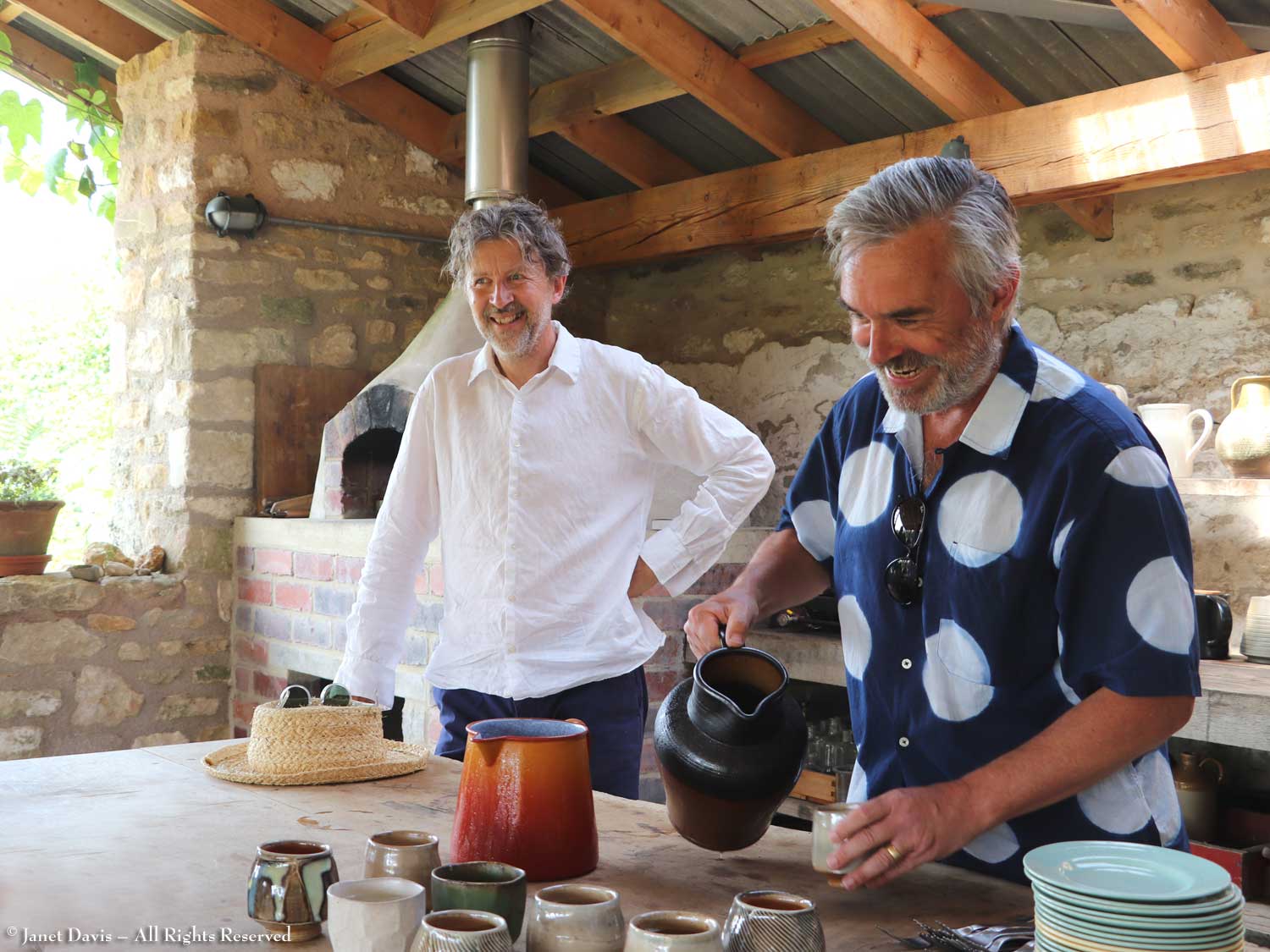
They went slowly, doing little for the first years. As Dan wrote in Dig Delve, “It took that long to know what to do with the place and what has felt right here.” In autumn 2012, they installed a pair of 18th century granite troughs used originally for tanning leather, now intended to gather rainwater. Once the steep land grade was levelled on this upper spine, the troughs would connect the house with the barns and form the gateway to what would become the new kitchen garden beyond.
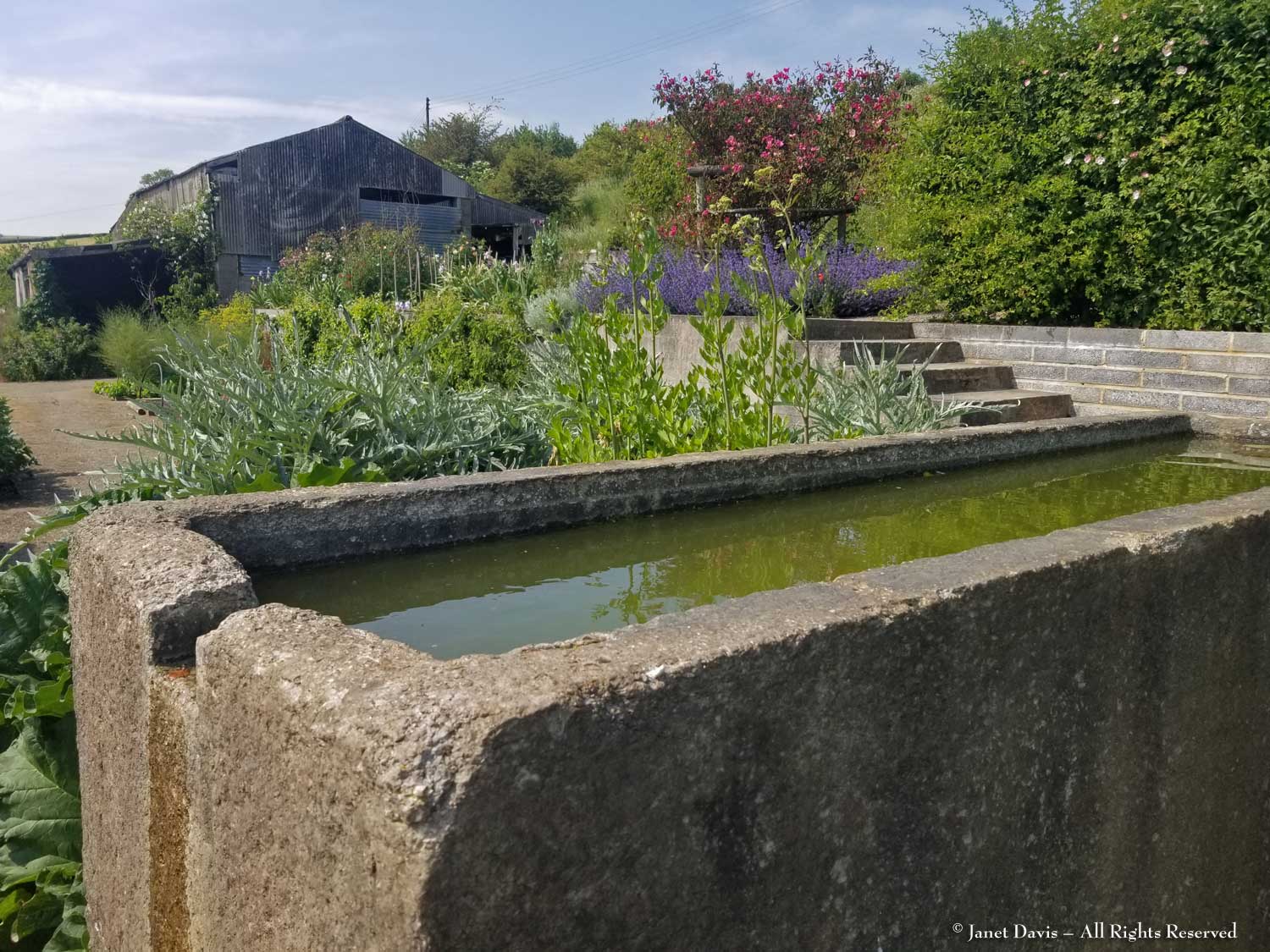
The horizontal line of the troughs, in the background below, also echoes the horizontal line of 52 ancient beech trees on Freezing Hill in the far distance, which occupies a Bronze Age landform between Somerset and the Cotswolds.
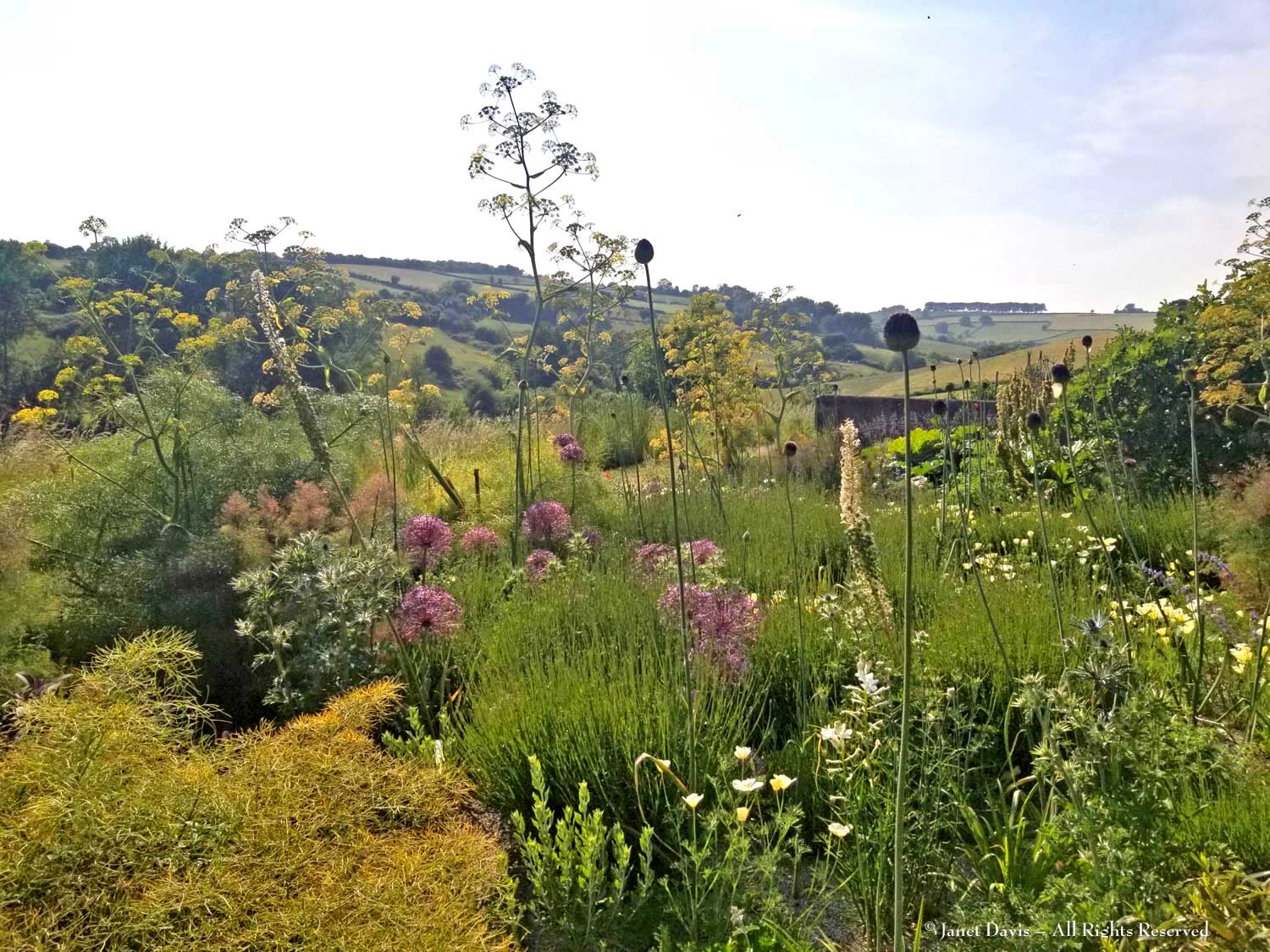
In gravelly rubble between the house and the troughs, Dan grows favourite clumping plants such as eryngium and calamint along with a host of self-seeders: cephalaria, corn cockle, silvery ballota, poppies, blue flax and a white California poppy (Eschscholzia californica ‘Ivory Castle’).
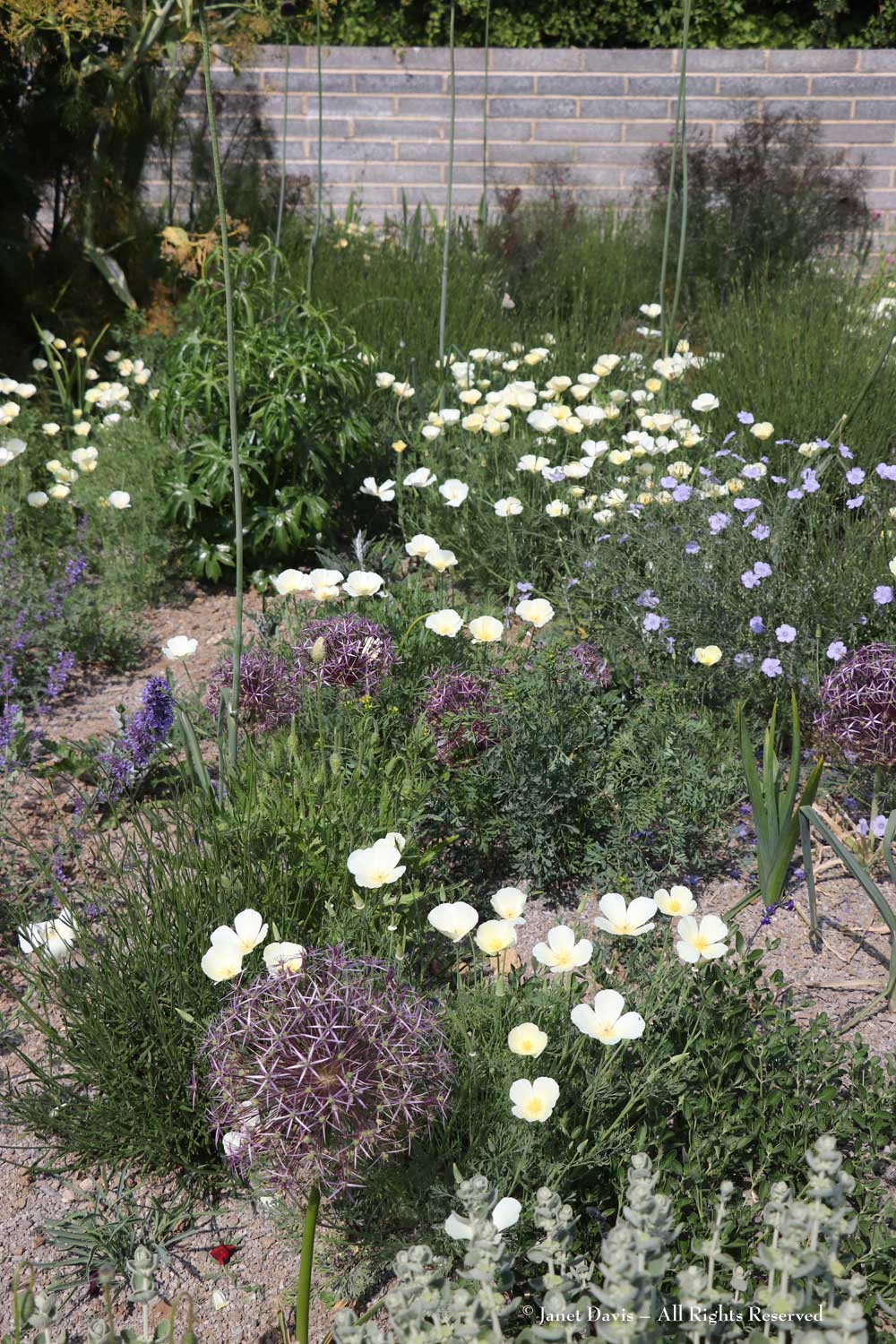
To understand the initial challenges posed by the steep lie of the land, it’s helpful to read Dan’s essay The Kitchen Garden tracking the 4-year progress from the trough installation to the first harvest. As he wrote, “When we arrived here the flat ground was literally no more than a strip in front of the outbuildings. We perched a table and chairs there to make the most of not being on the angle”. Gardening on the steep hillside was a challenge: “Sowing, thinning, weeding and harvesting on a slope were all that much harder with one leg shorter than the other and tools and buckets balanced.” In time the ground near the barns was leveled and a breeze-block wall built to hold back the sloping fields above, to reflect heat and the fragrance of perfumed plants……
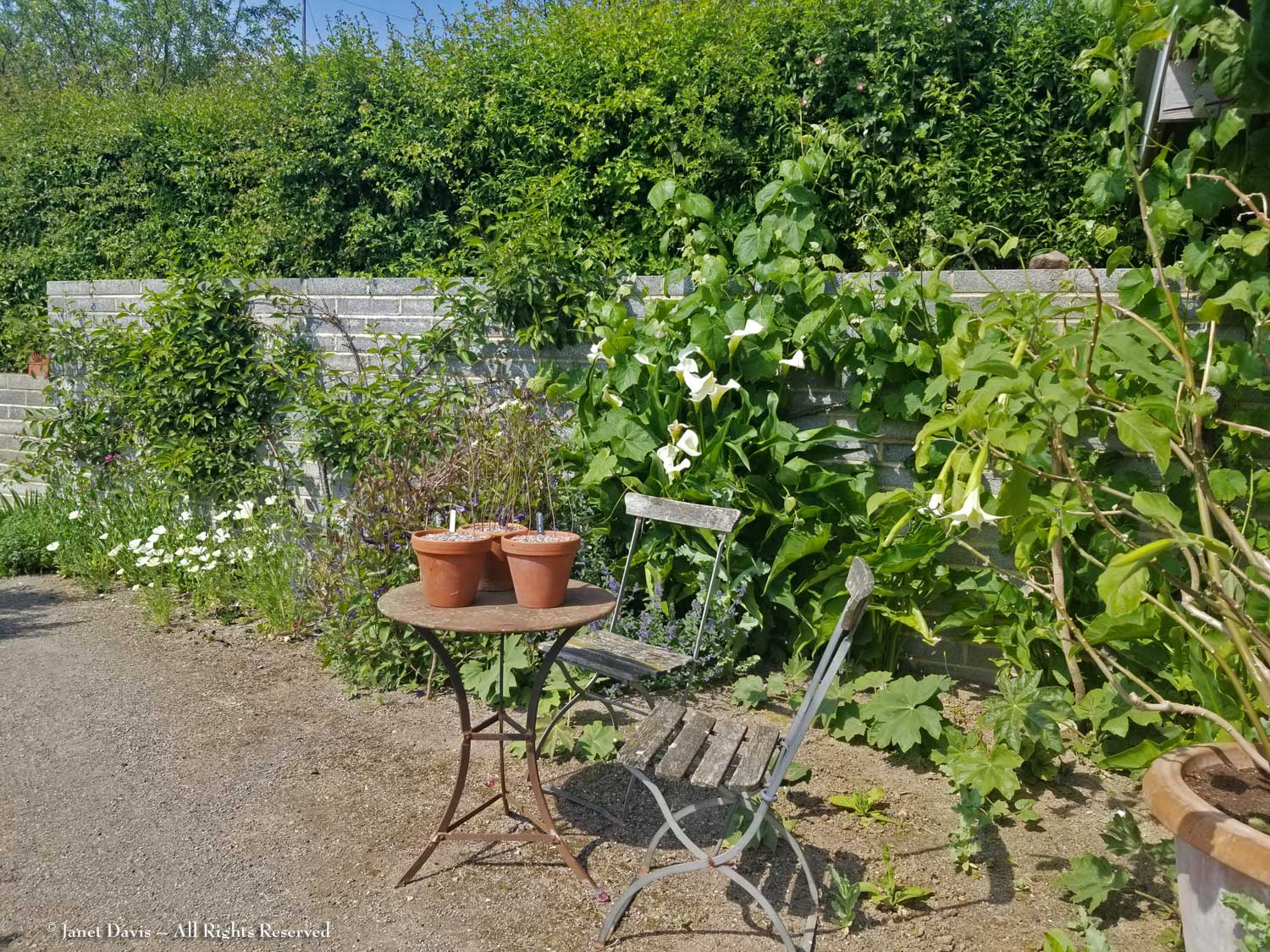
…. and to give fruits such as cordon-espaliered pears, below, a warm surface on which to ripen. A fig in this area is a cutting of ‘White Marseilles’ from Dan’s project at Lambeth Palace, the parent plant “brought from Rome by the last Roman Catholic Archbishop of Canterbury, Cardinal Reginald Pole, in 1556.”
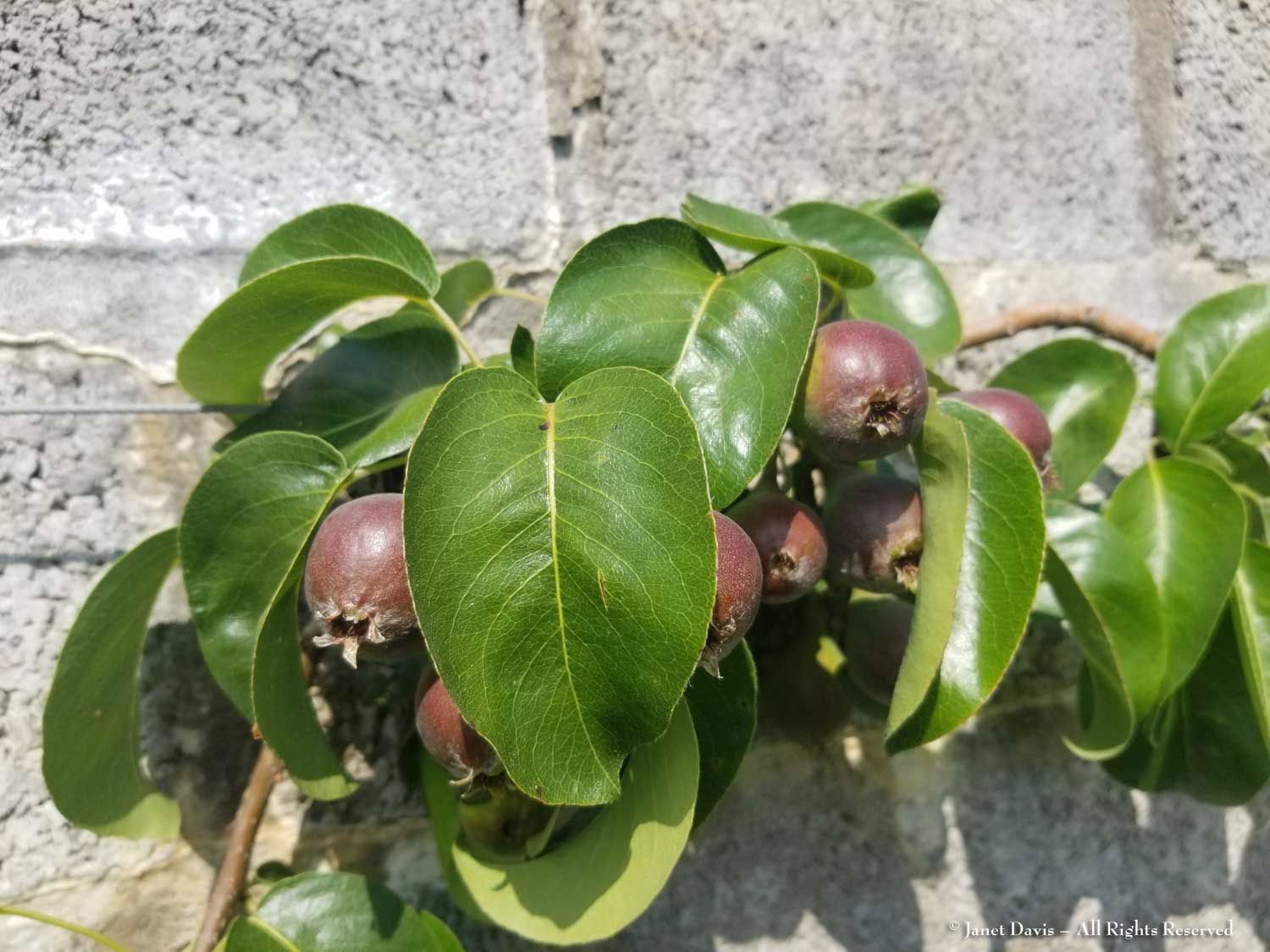
In the early years, trees were planted: several in a new orchard; some in a ‘blossom wood’ of native species; hazels and alders down by the stream; memorial trees to honour missed friends; and a katsura grove in the valley with its exquisite autumn perfume to evoke Dan’s long project at Tokachi Forest in Hokkaido, Japan. Trial beds held David Austin roses for cutting, 56 varieties of dahlia and a rainbow of tulips. Signature plants appeared, including different species of towering giant fennel (Ferula spp.), a Mediterranean plant I saw first in the ruins of Troy many years ago, so it always makes me think of Homer to see it now. Dan has used Ferula communis subsp. glauca in his design for the Delos Garden at Sissinghurst. (More on that later.)
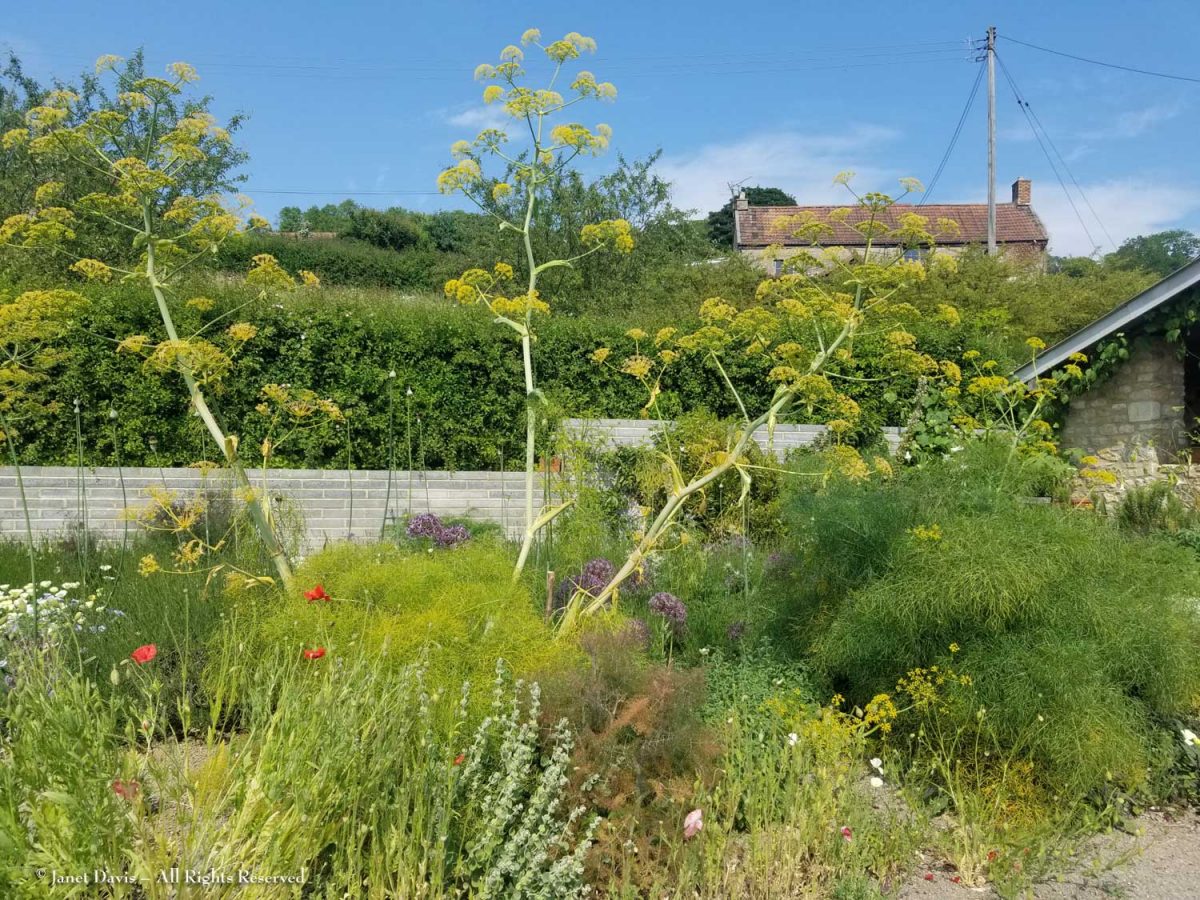
Rusticity and a sense of place is preserved in the tin walls of the barn, a backdrop to feverfew, bronze fennel and the unusual lilac-purple valerian, Centranthus lecoqii.
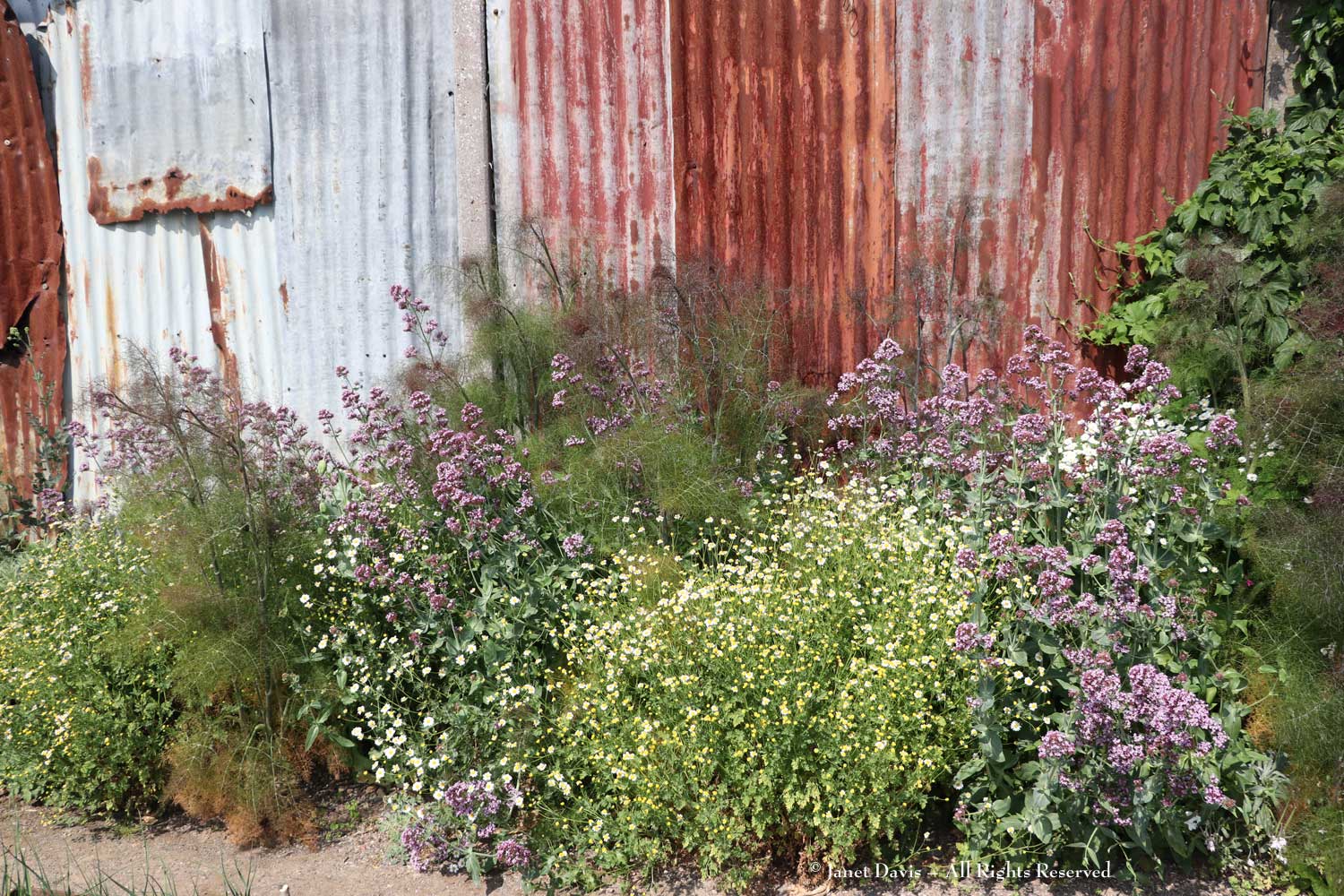
English gardeners seem to grow more umbellifers than I’ve counted anywhere in my North American travels, and I had to ask Dan twice the name of the lovely one below. It’s Athamanta turbith, a cold-hardy native of the Balkans.
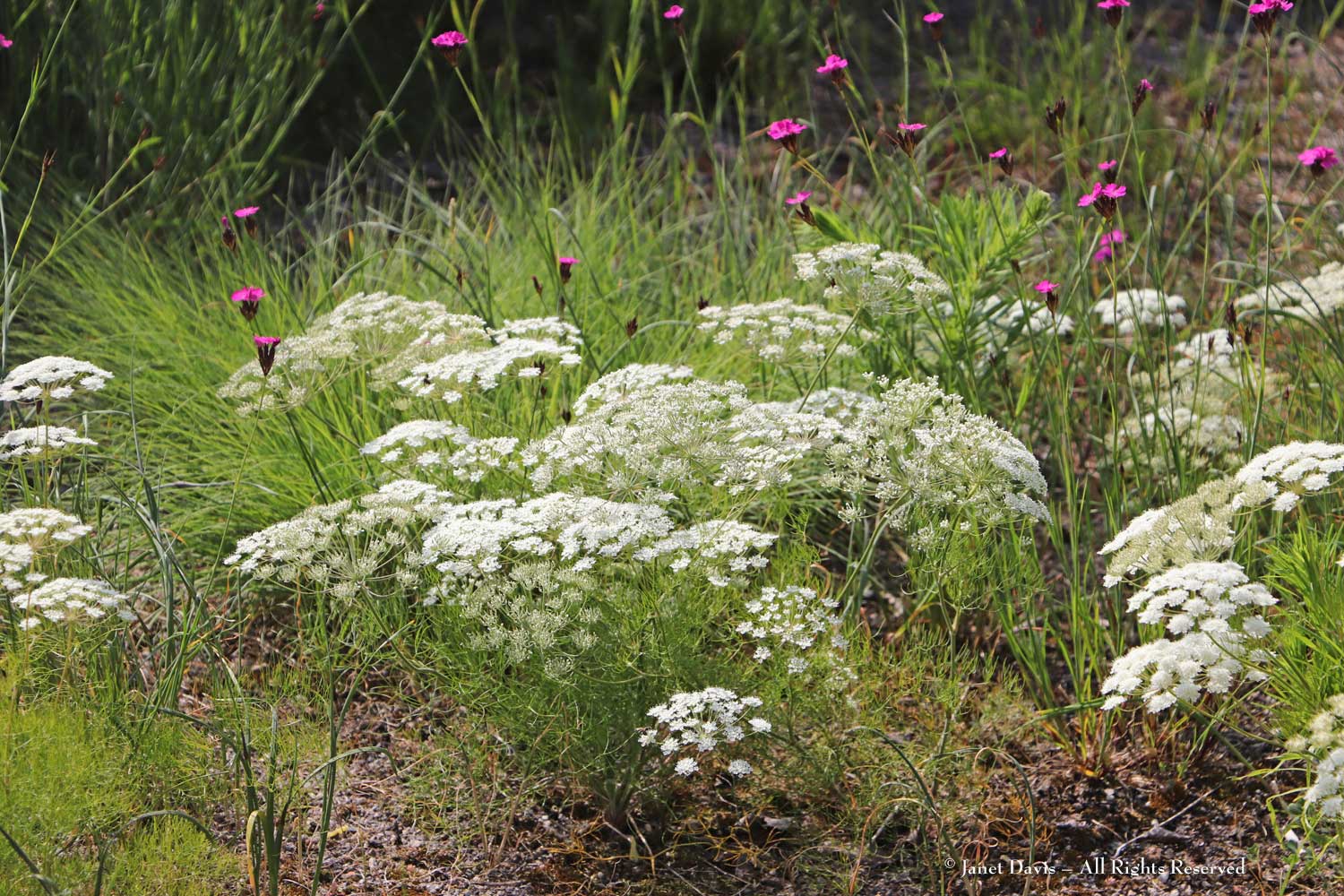
Another plant used by Dan in Delos at Sissinghurst also appears in this upper garden: tall pink Dianthus carthusianorum, shown here (in terrible sunlight, sorry) with Achillea ‘Moonlight’.
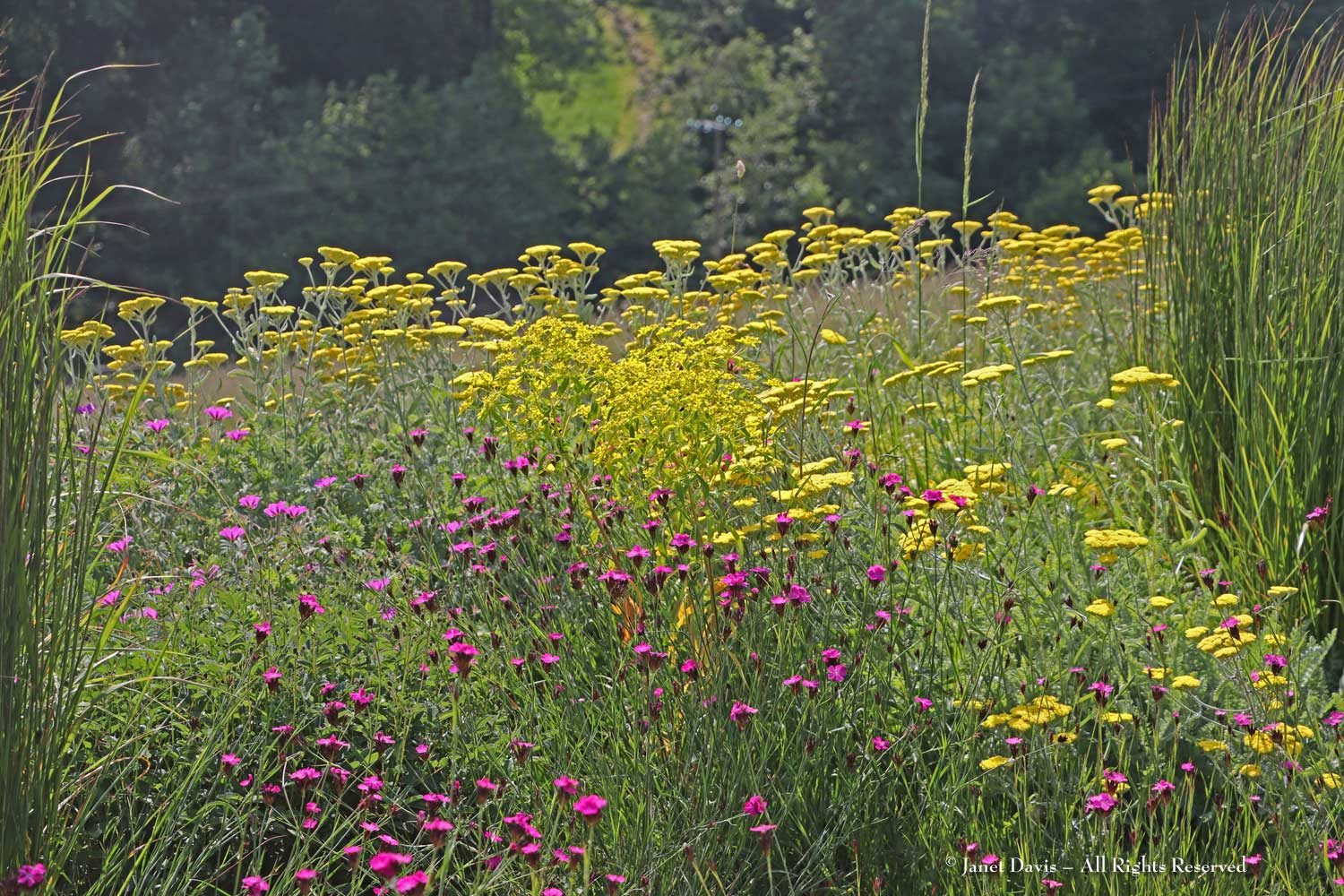
Constructed in spring 2014, the kitchen garden comprises a double row of steel-edged, rectangular beds with a broad walk in-between.
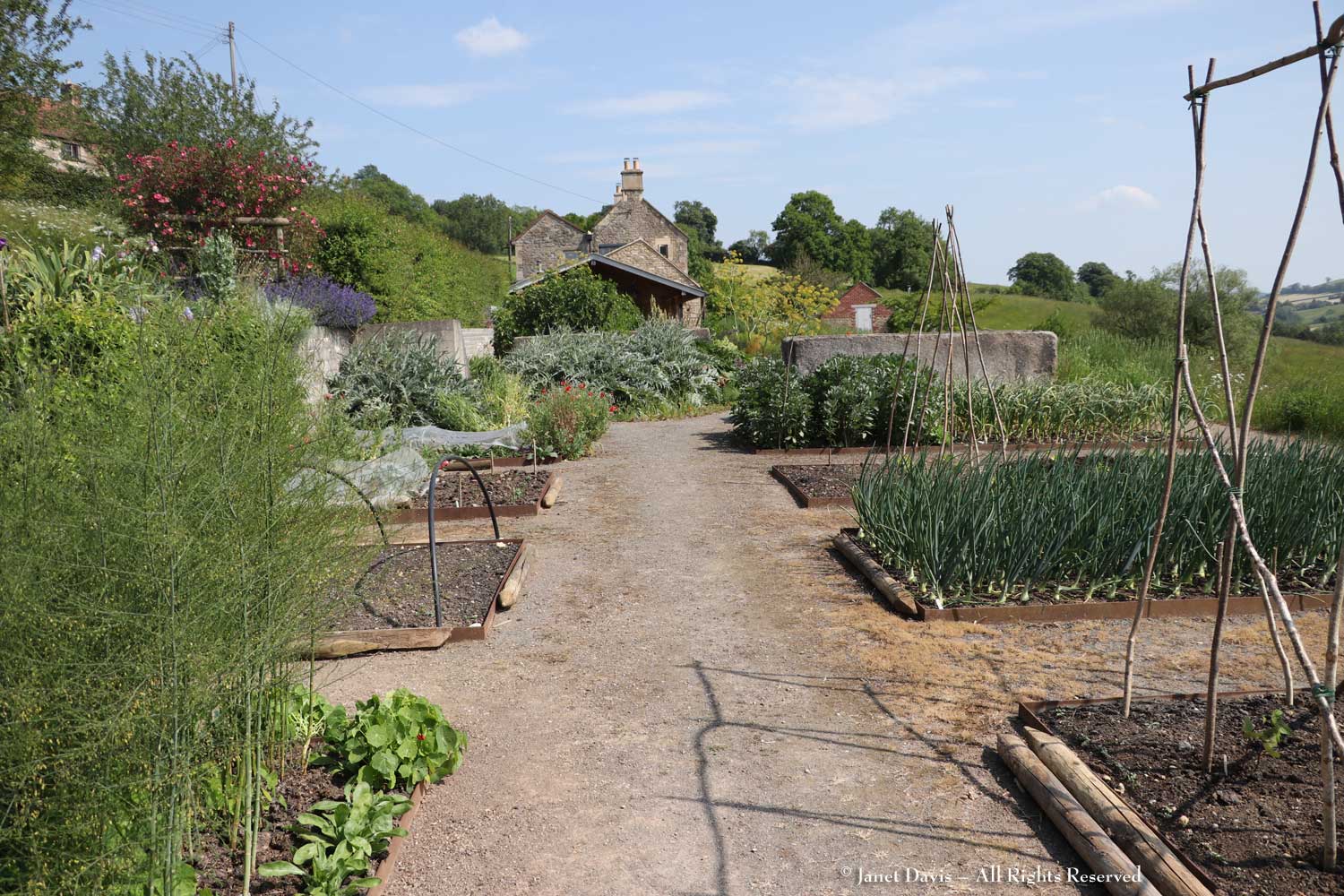
The soil where the vegetables grow is rich and productive. According to an elderly neighbour, in the 1960s the former owner’s parents grew vegetables in a market garden on the slopes, and berried boughs from holly trees still standing were harvested for Christmas wreaths for the market.
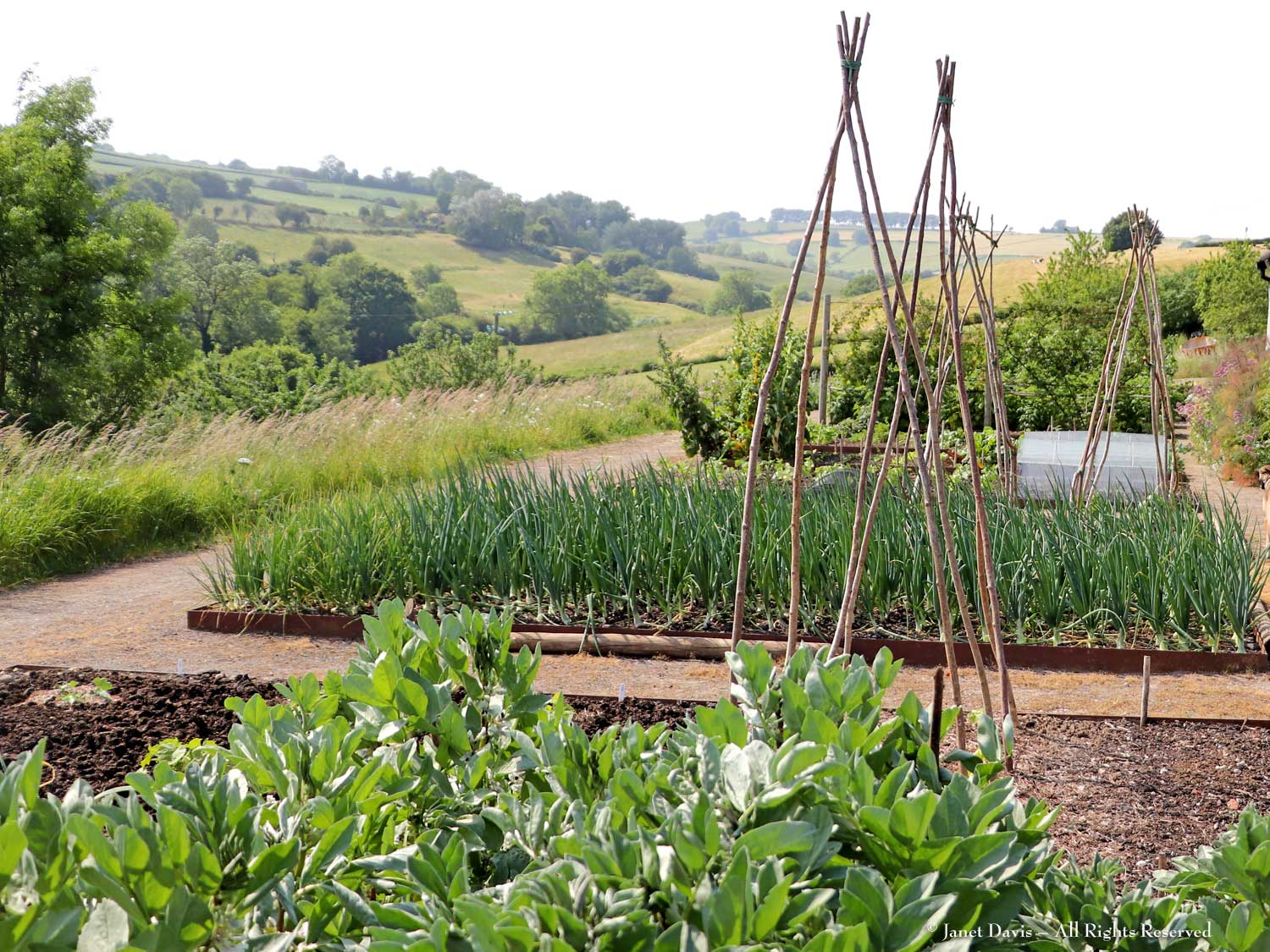
Creative trellising allows vertical growing of cucumbers and summer squash. Other crops include courgettes, French and runner beans, peppers, salad greens, carrots, turnips, beets, sweet corn and tomatoes (in a poly house).
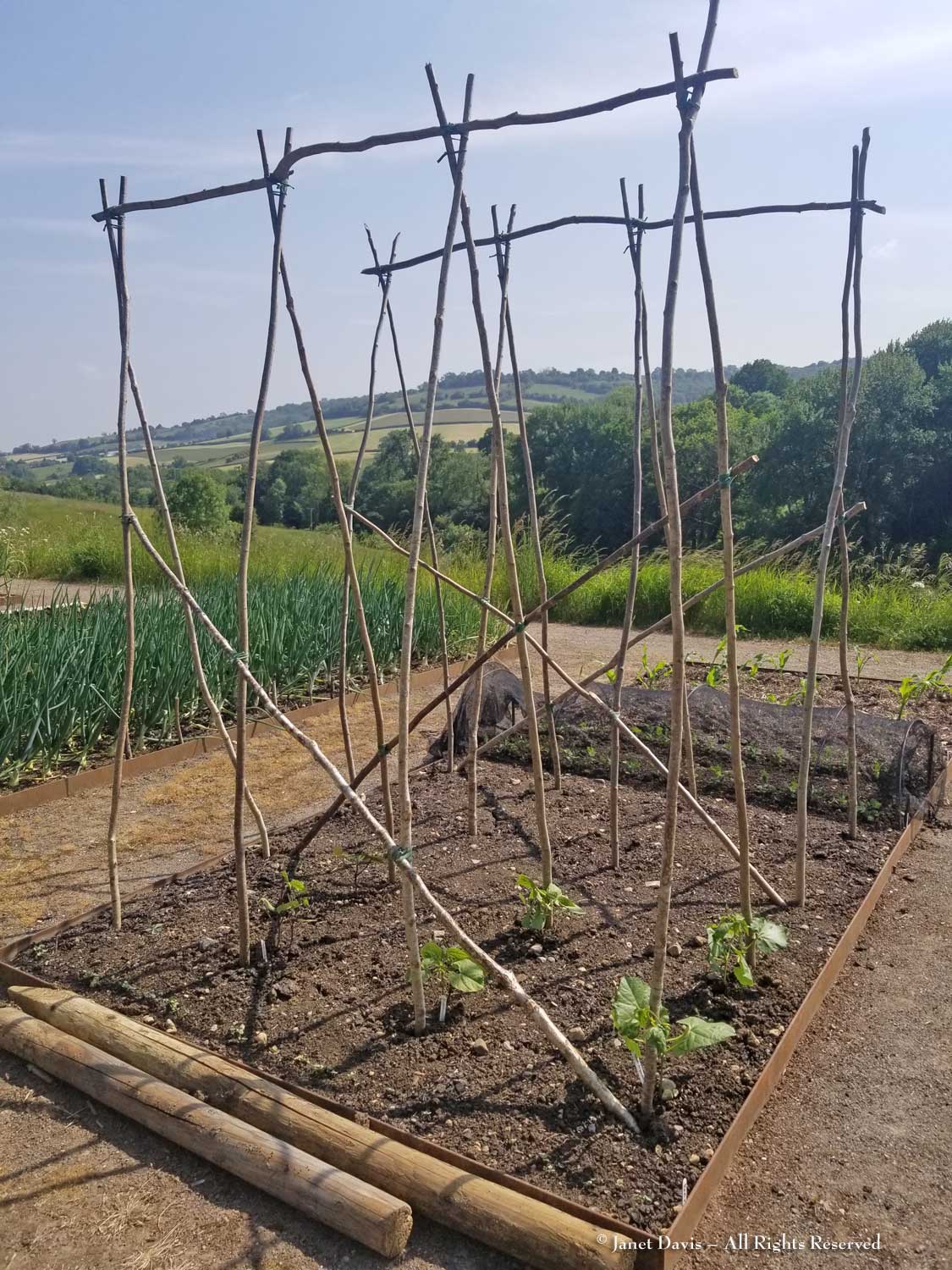
Berries and currants are grown in beds with frames that can be netted later against birds.
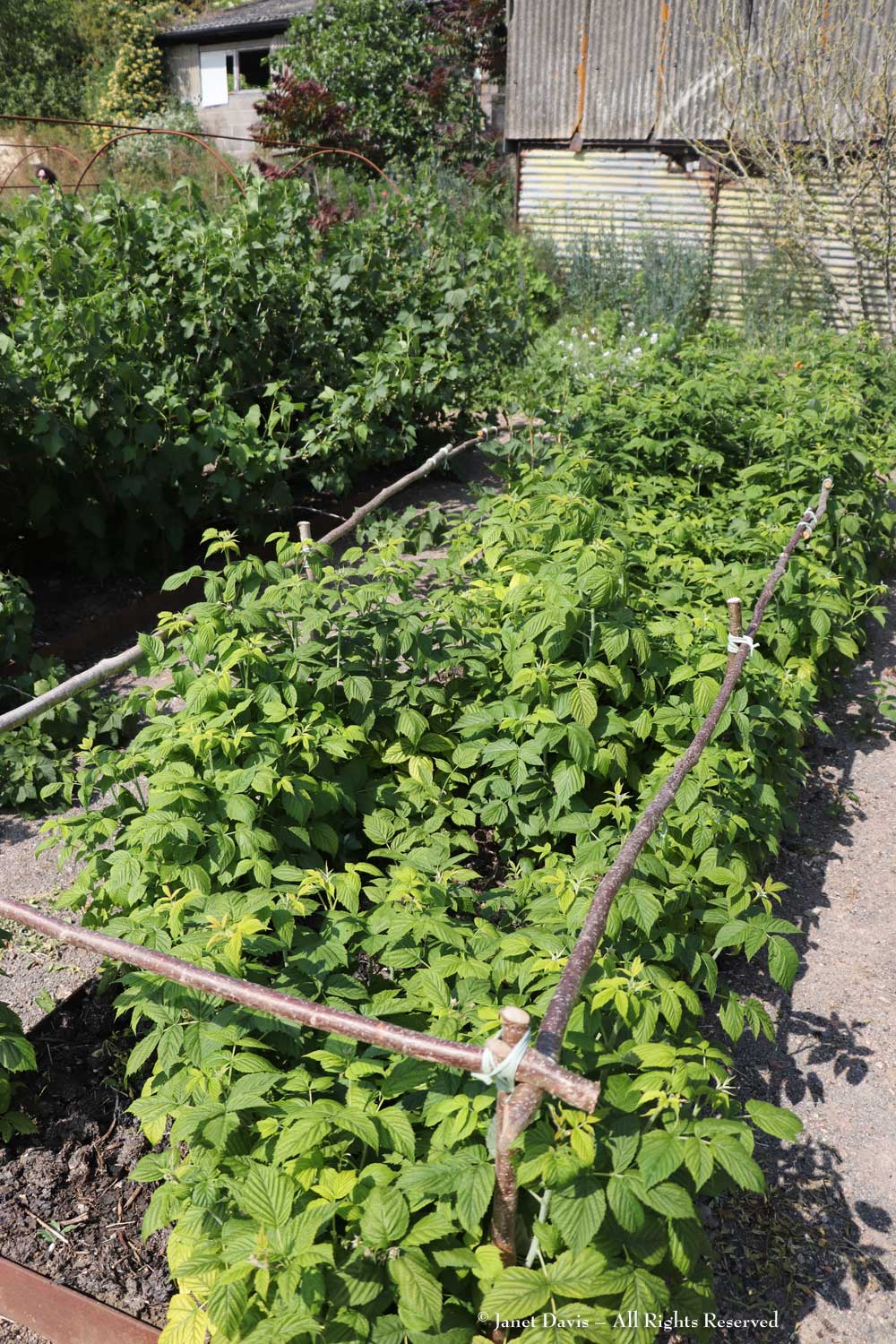
Three varieties of rhubarb are grown at Hillside, providing the ingredients for Huw’s delectable rhubarb galette.
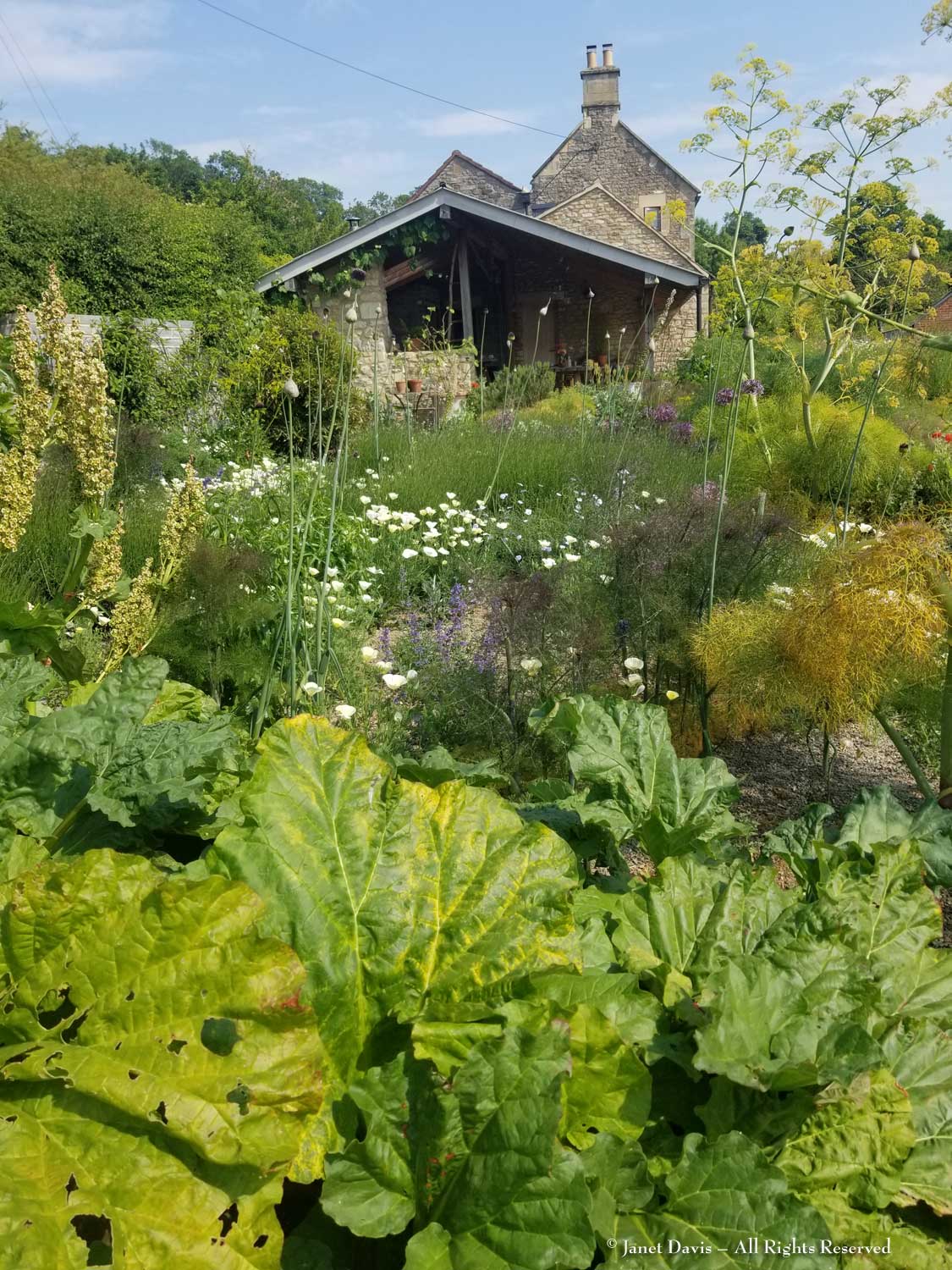
Time is fleeting and Dan leads us down a path through the meadows towards the brook. When I look up the hill through a bouquet of massive Gunnera manicata leaves….
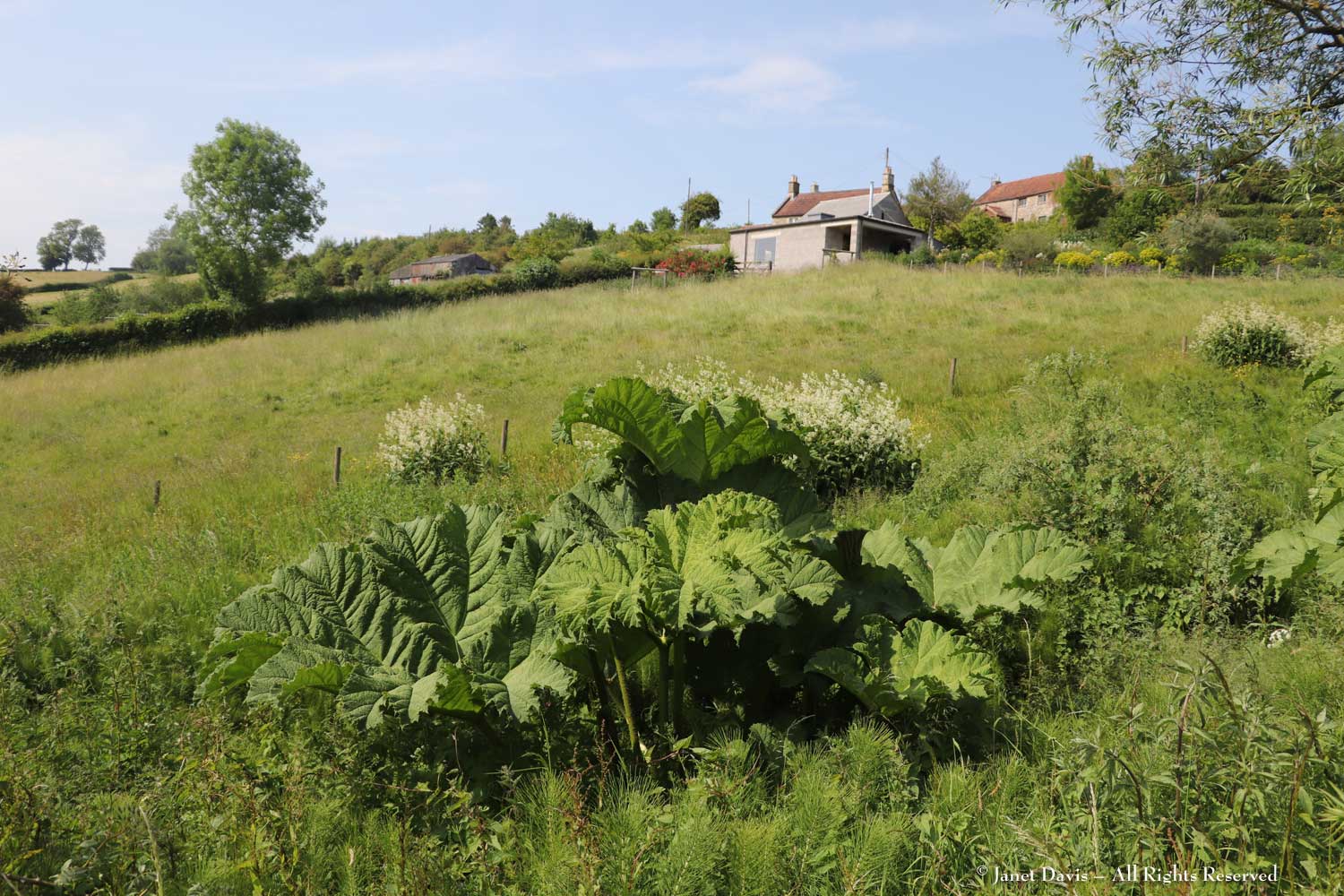
….. that I literally held above my head as I passed under them a moment earlier, illustrating the deceptive scale, I see the cluster of buildings at the top. Closest is the milking barn, now the studio office where Dan and Huw carry out their design work. To its right is the main ornamental garden, which we’ll visit in a few minutes.
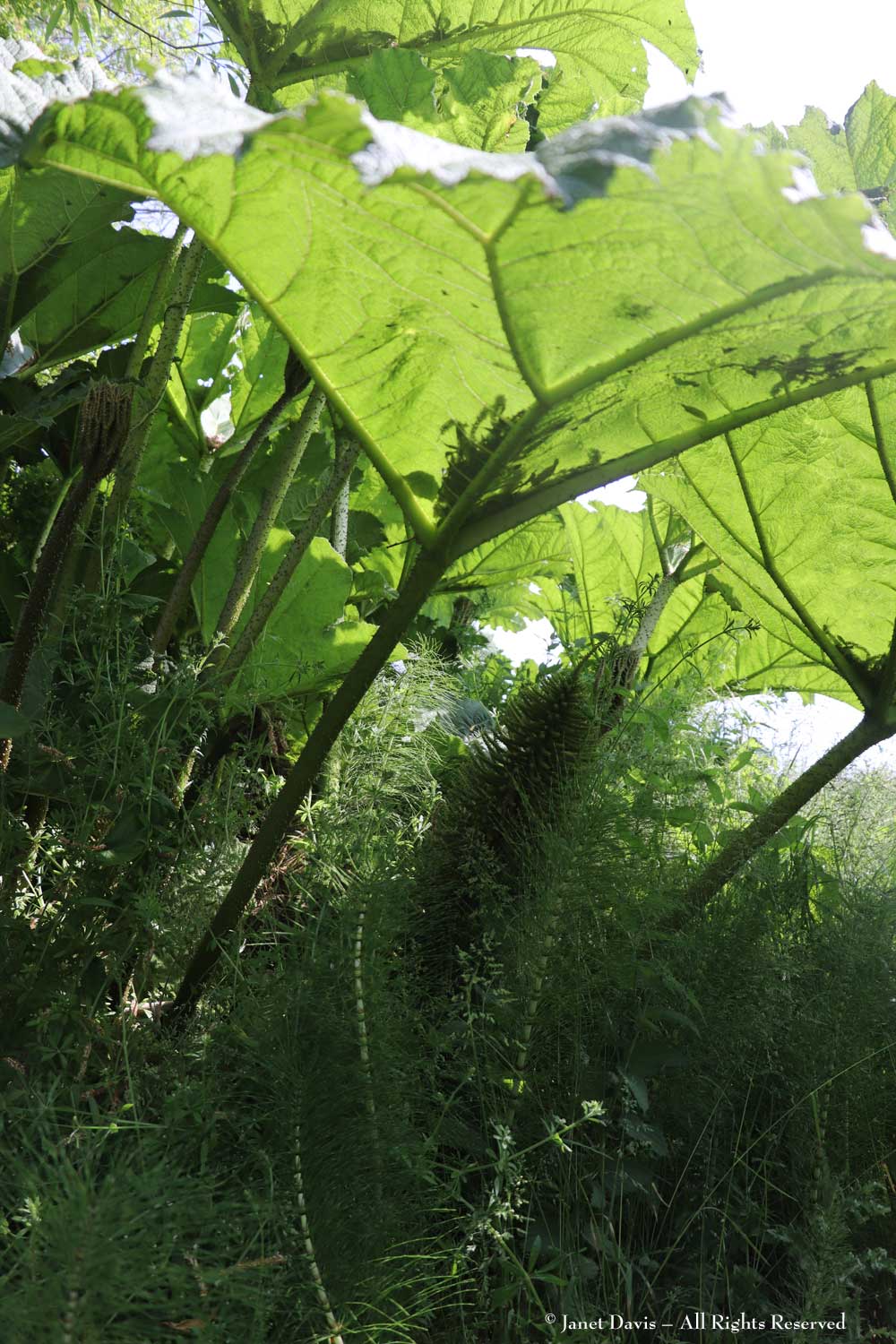
On the way to the pond, Dan pauses in the meadow surrounded by oxeye daisies (Leucanthemum vulgare), buttercups (Ranunculus acris) and black knapweed (Centaurea nigra). He is in the process of overseeding the meadows with yellow rattle and native orchids, including gift seeds harvested by Fergus Garrett at Great Dixter, to improve the biodiversity here.
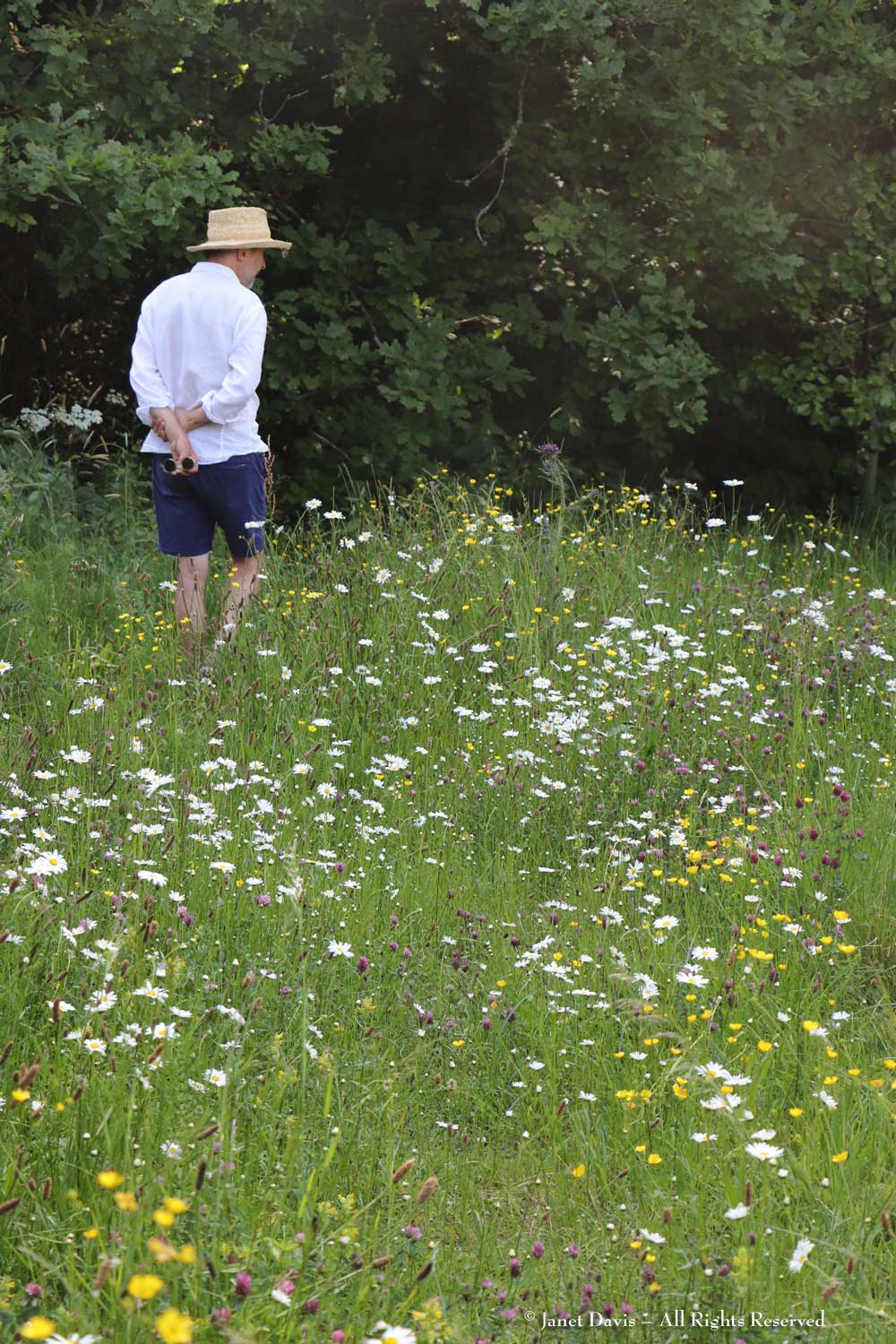
The pond is just two years old, the marginal plants still finding their feet. But water has always been important to Dan in a garden – and this pond might host two-legged swimmers, as well as aquatic flora.
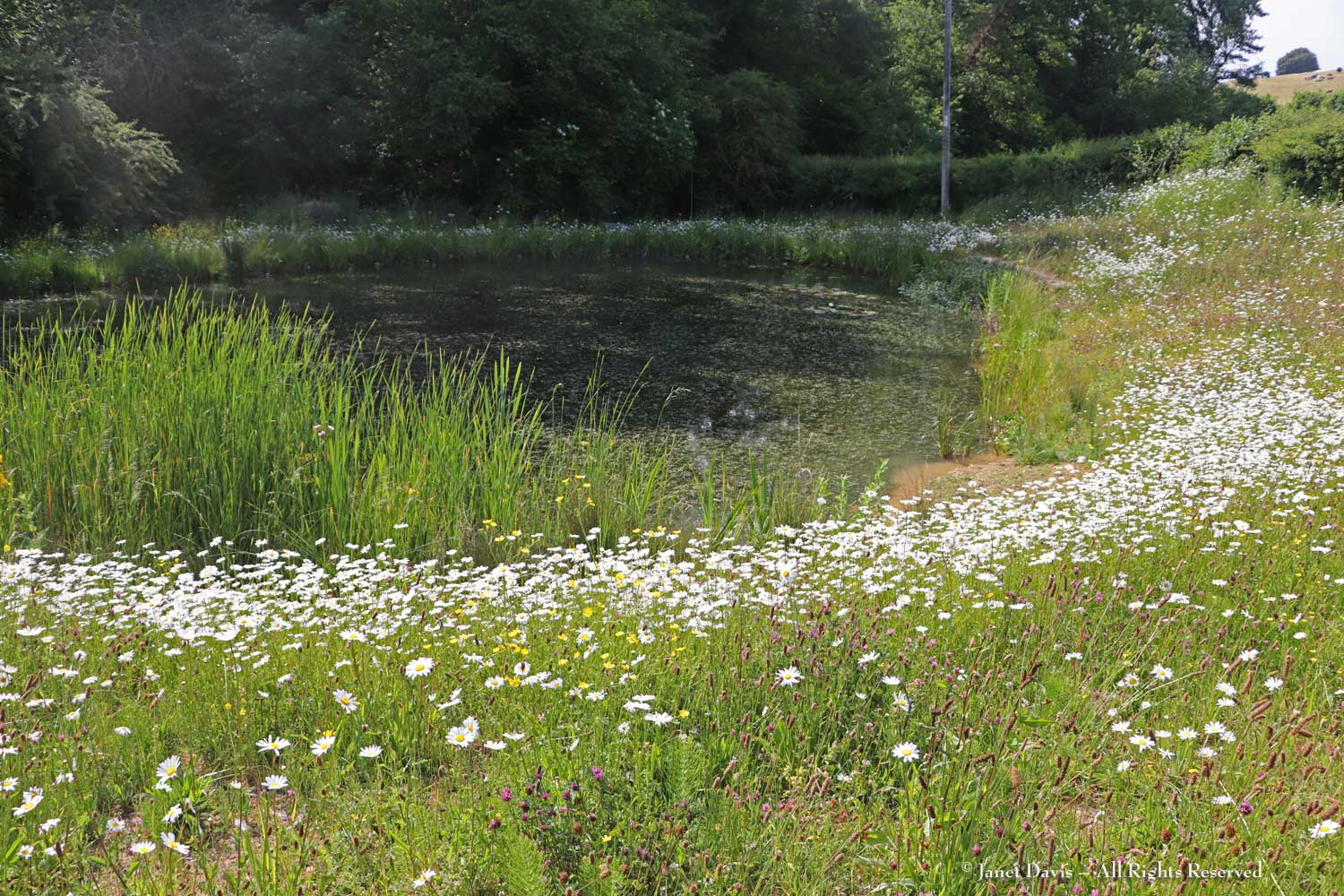
I am fond of meadows, having grown one or two myself, so I take note of the red campion (Silene dioica)……
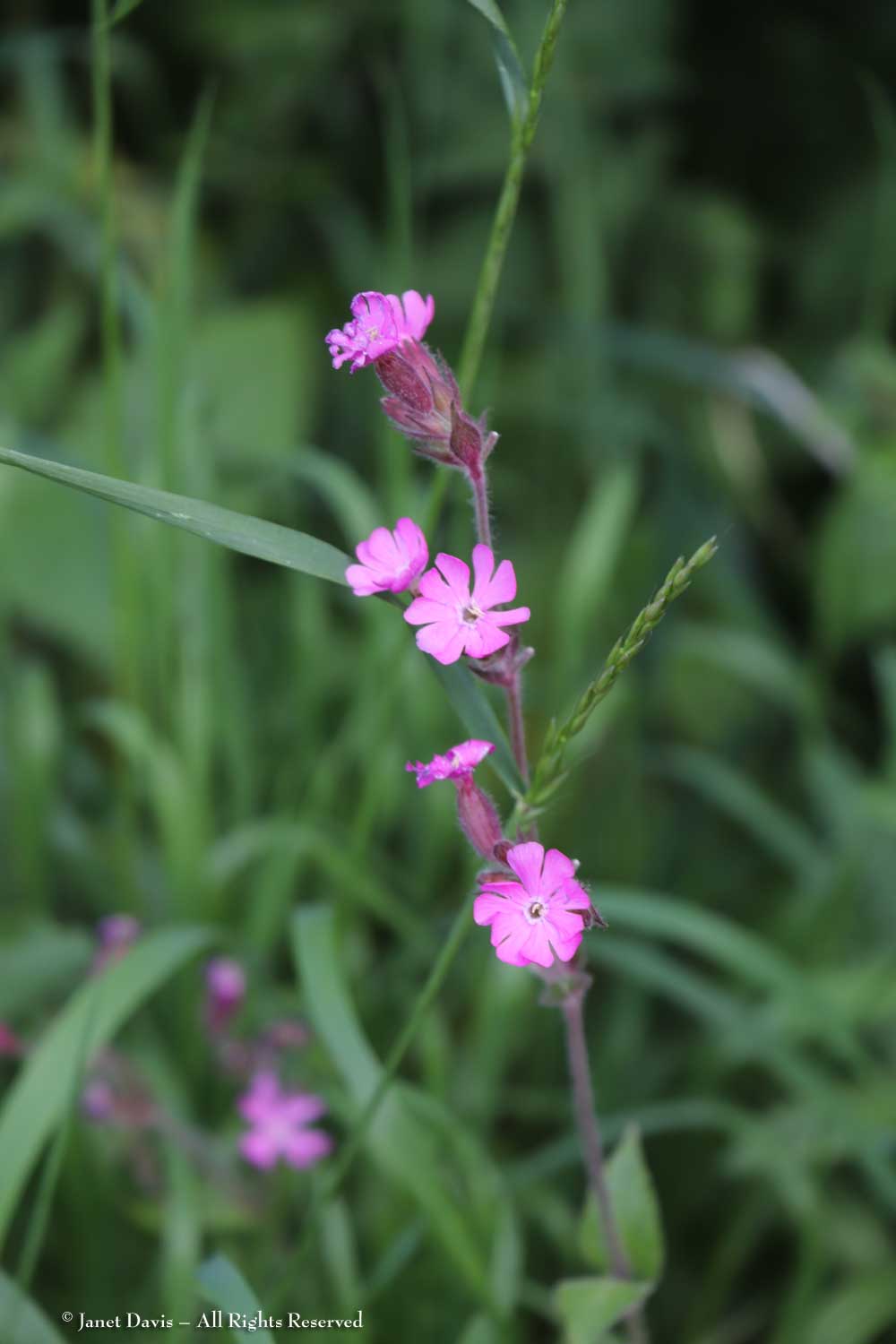
….. and blue-flowered Caucasian comfrey (Symphytum caucasicum).
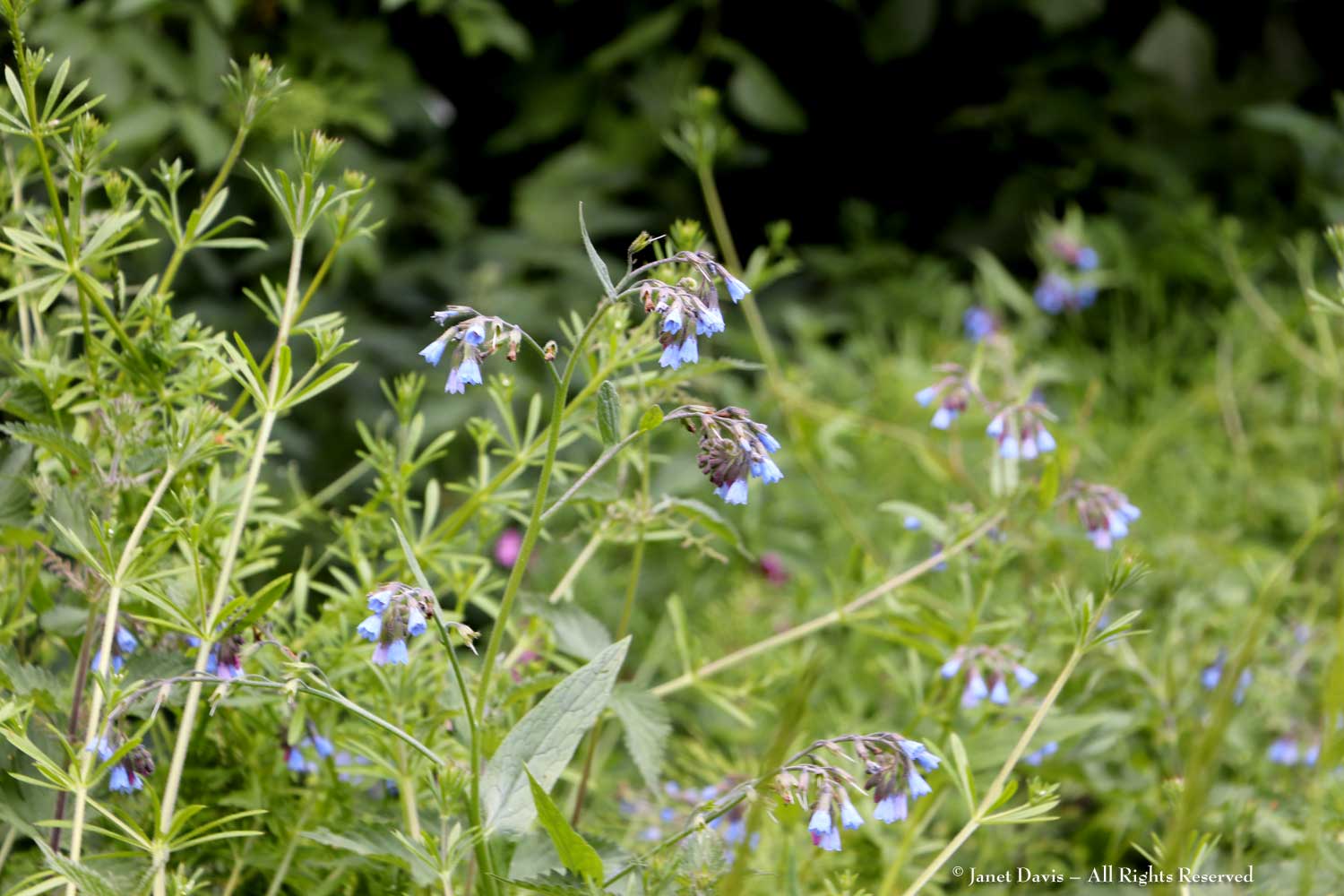
Water runs in a ditch through parts of the low meadows and after planting the banks with marsh marigolds and snowdrops, Dan sought to add small bridges. Apart from a pair made of stone, he riffed on Japanese landscape design with his own timber zig-zag bridge.
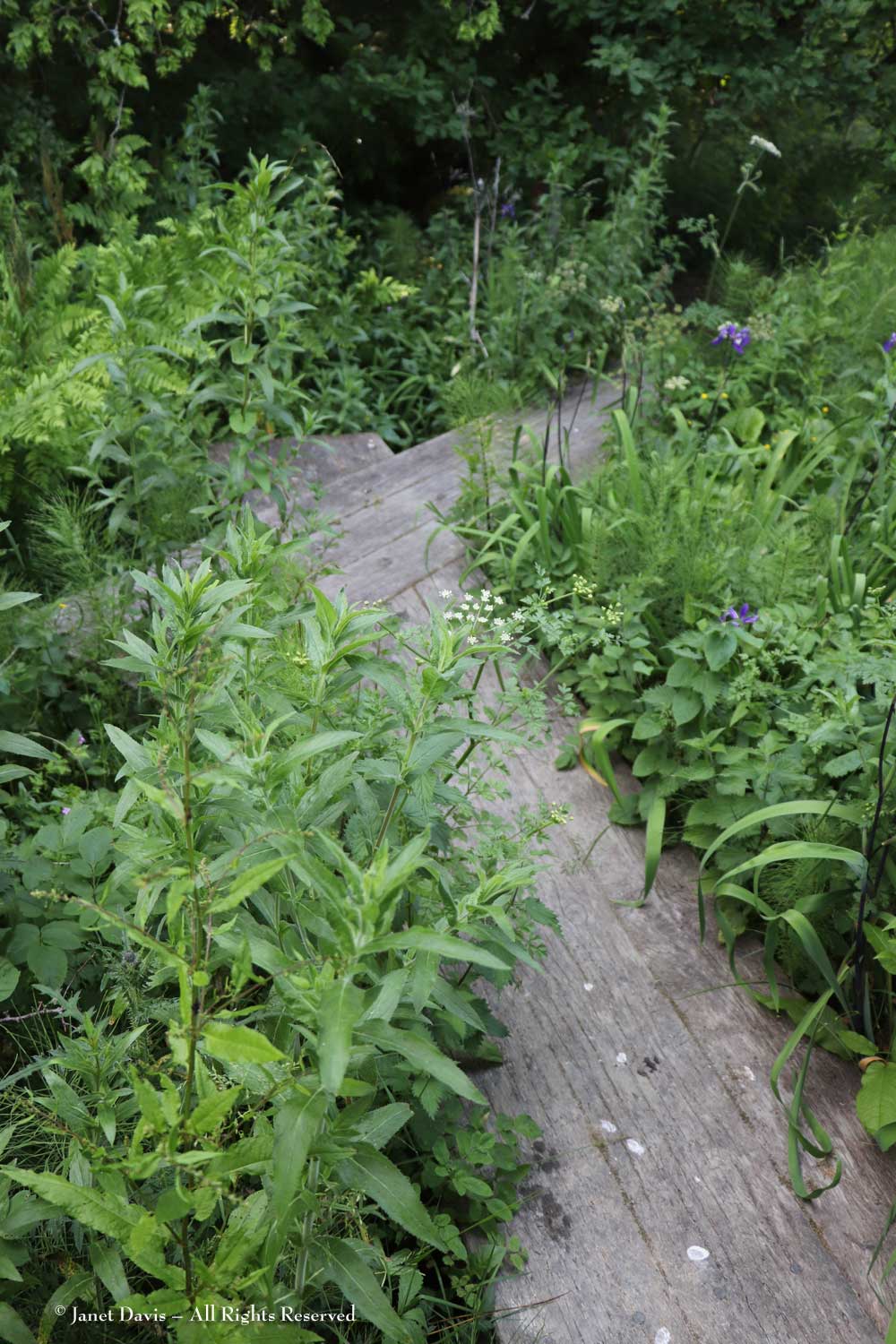
In the damp ground alongside the bridge grows Iris x robusta ‘Dark Aura’.
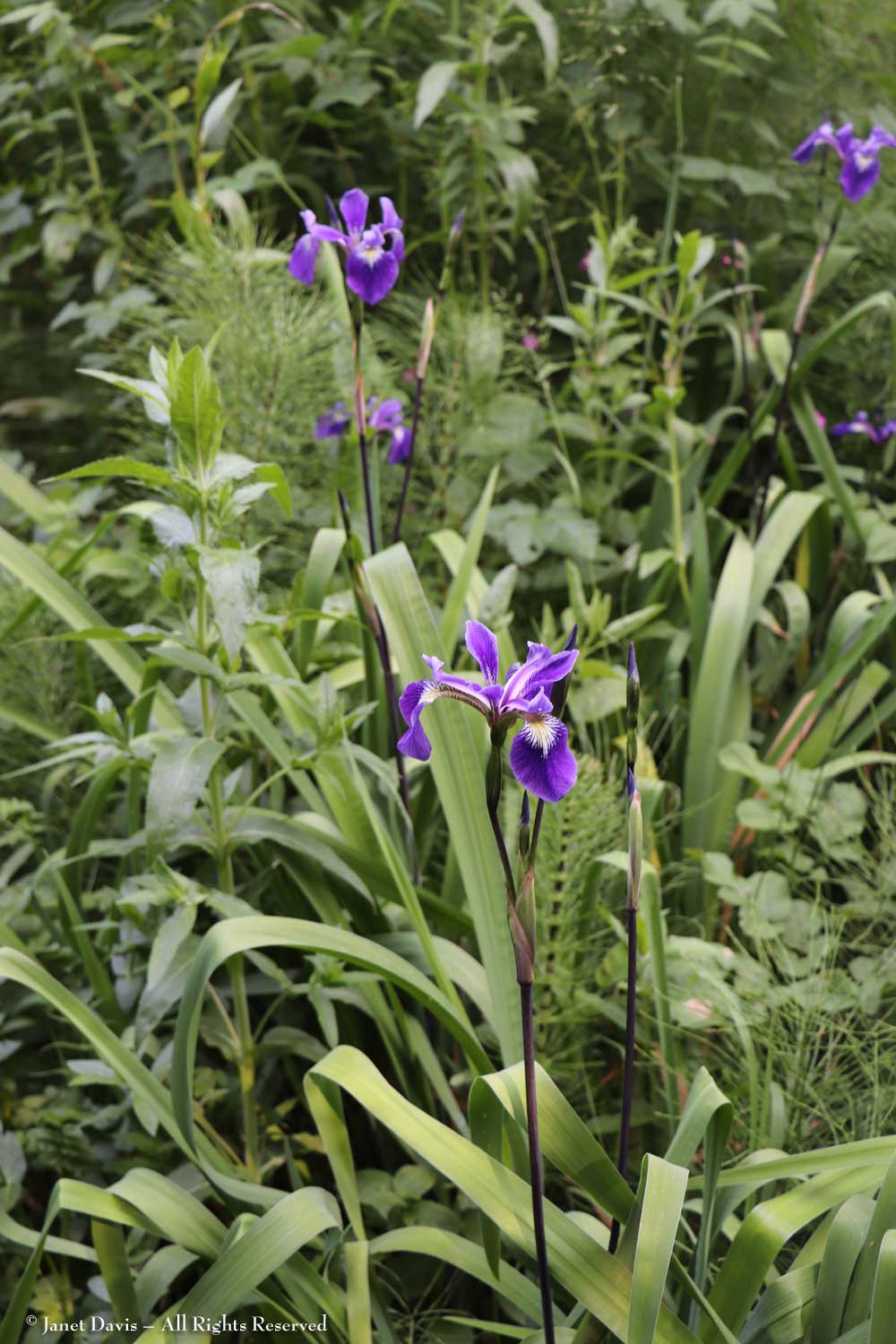
Despite watching my legs and hands as I navigate the paths, the stinging nettles (Urtica dioica) seem to recognize a feckless Canadian and soon I am rubbing my wrist with a dock leaf (Rumex obtusifolius) proffered by Dan. (It helps with the sting but I have impressive raised welts the next day that cause me to reflect on the traditional medicinal value of this common European plant which, I suppose, would cause you to forget about your chronic arthritis while your skin deals with the acute inflammation.)
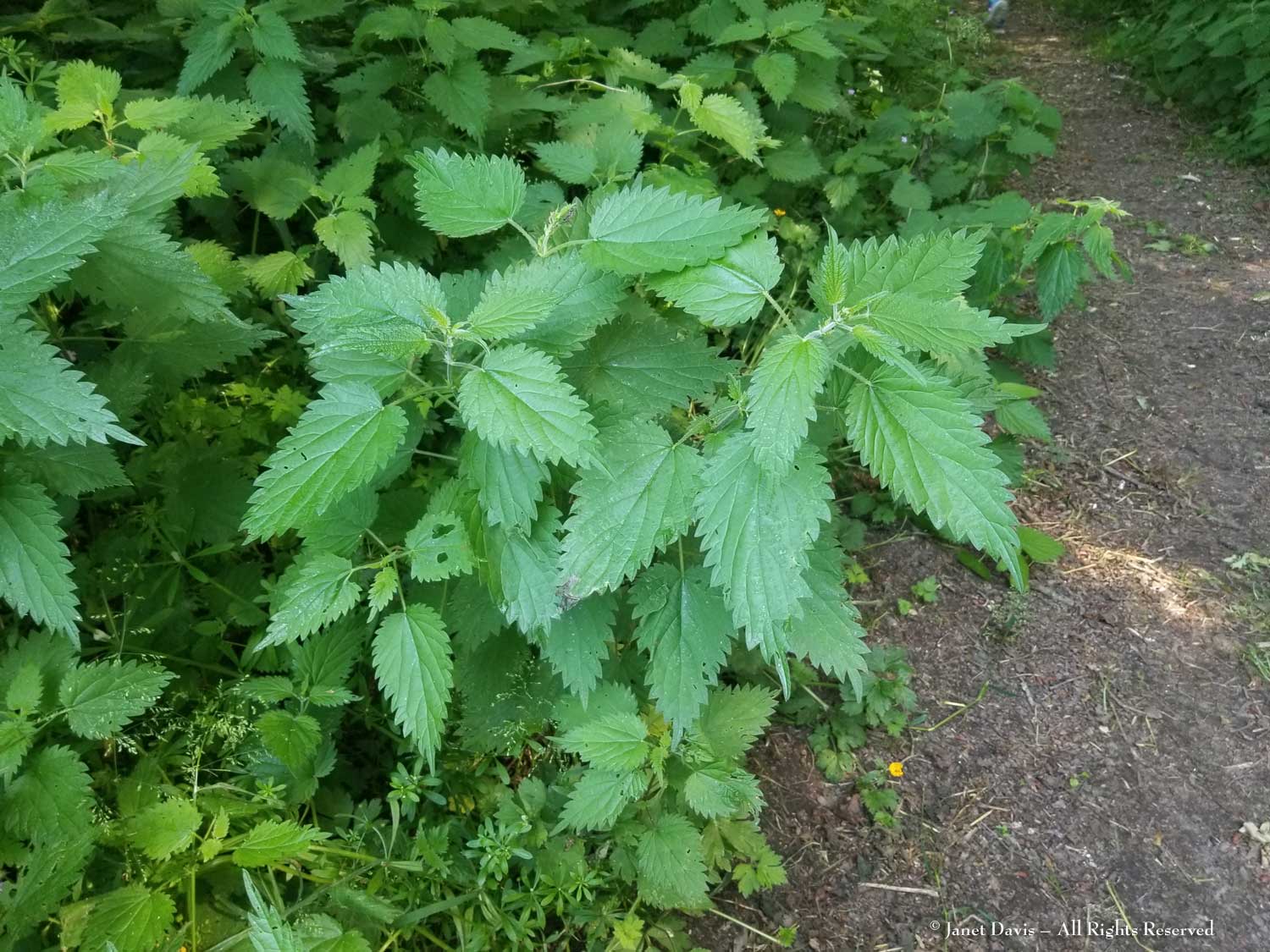
Back at the top, we are now let loose in Hillside’s ornamental garden, which occupies several large, irregularly-shaped beds on the upper slope. Planted in Spring 2017 and finished in Autumn 2017, it was the result of five years of waiting and planning. There is so much to see here, but not nearly enough time to study it carefully.
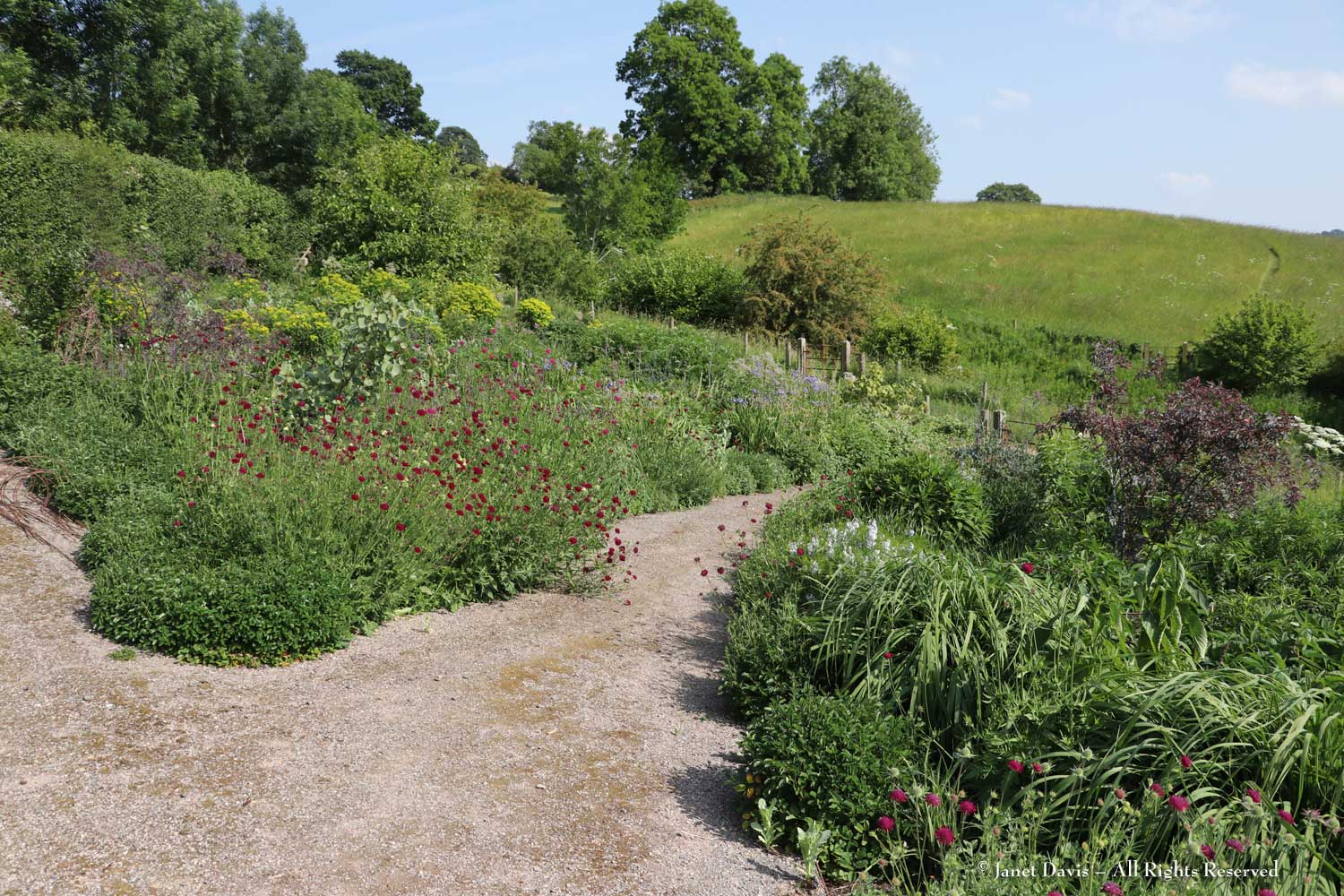
Burgundy Knautia macedonica is stealing the show, with yellow Euphorbia wallichii in the rear. The profusion of summer perennials and ornamental grasses is still to come, which we can glimpse thanks to Dig Delve’s back issues.
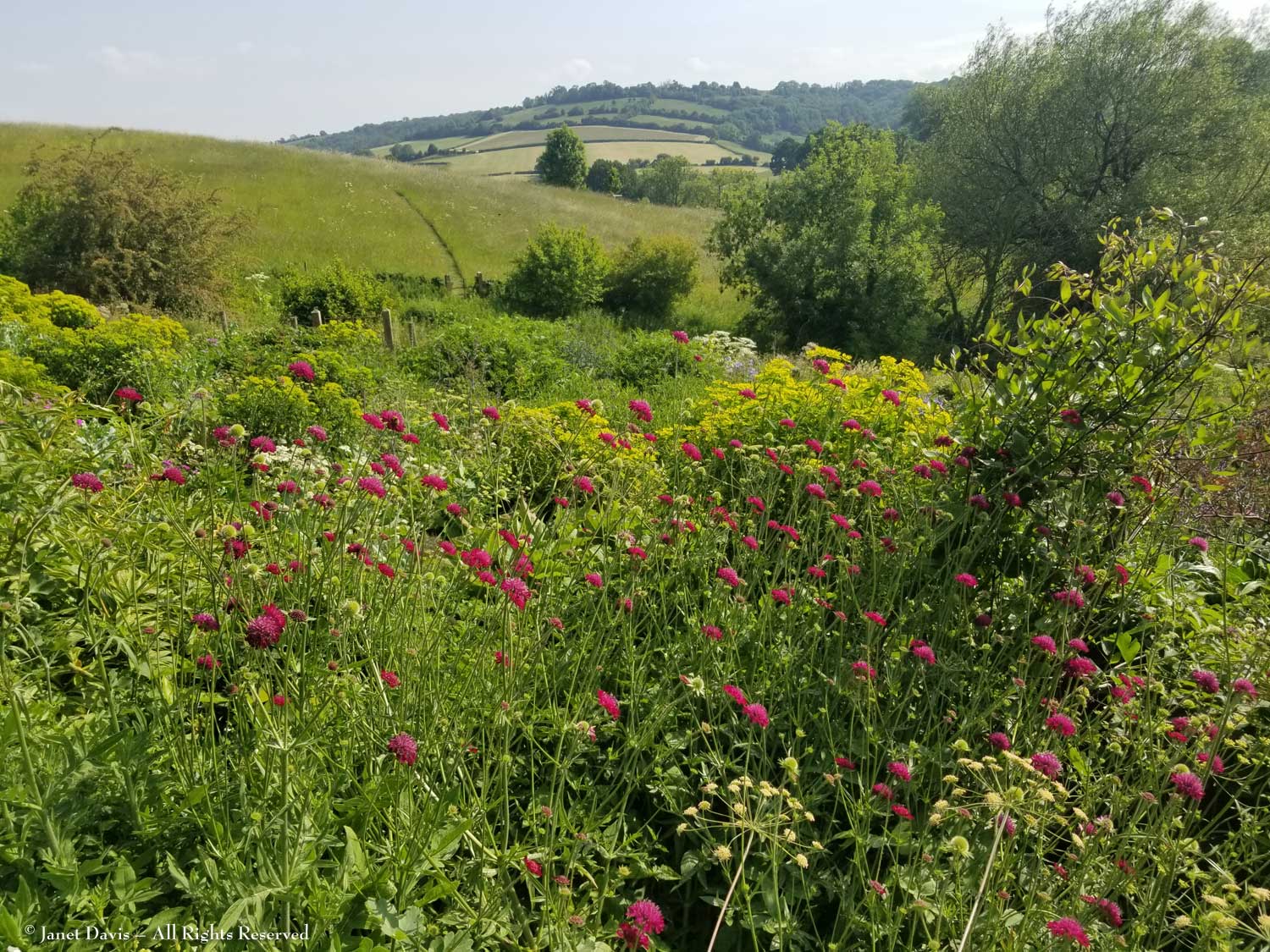
A dark opium poppy (Papaver somniferum) is the progeny of gifted seed from plants Dan saw when cycling to work in his early 20s. It is the only variety he grows, careful not to let it hybridize with the mauve and pink ones his neighbours grow.
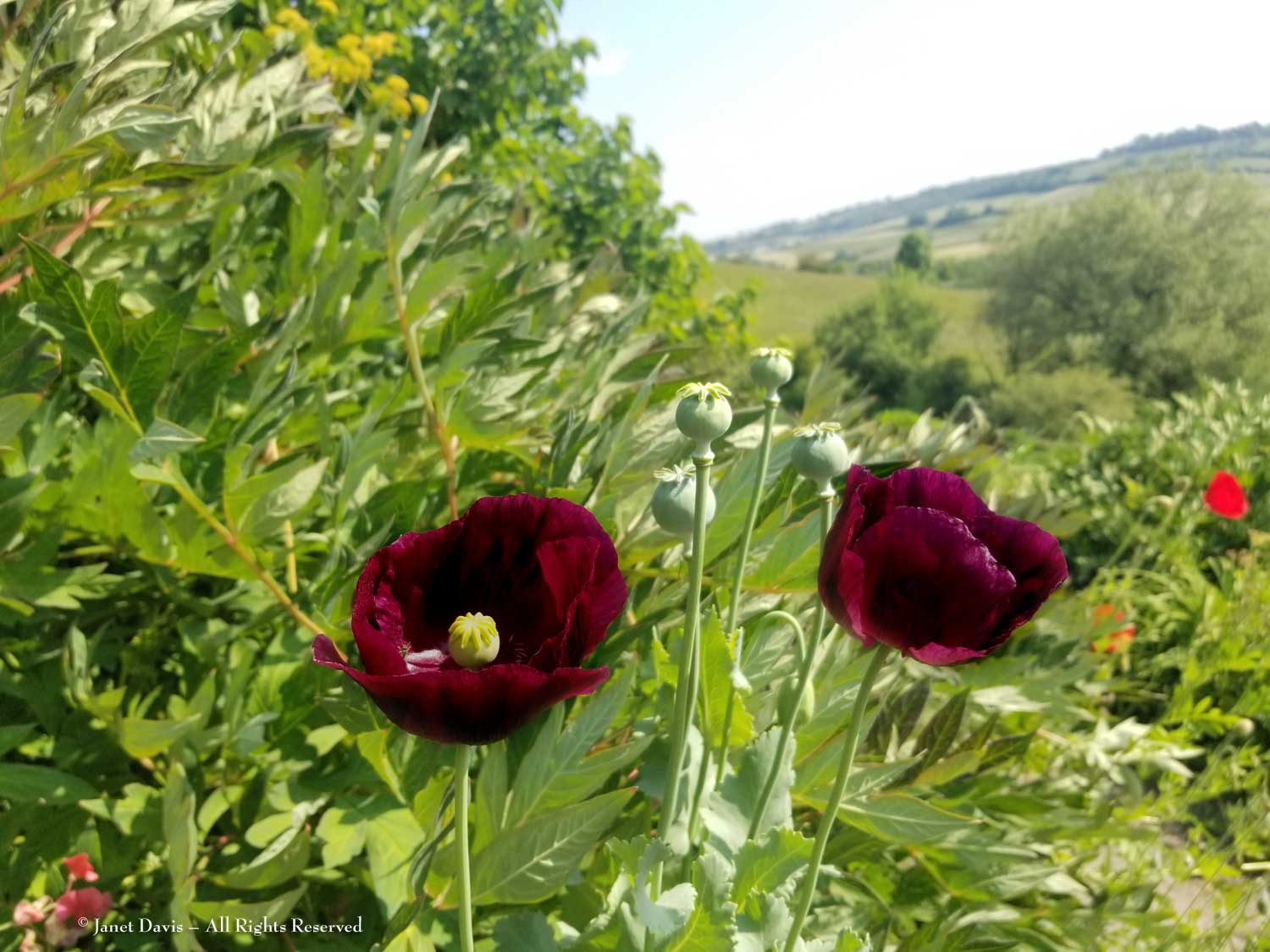
The ornamental garden is a keen plantsman’s lair and it is such fun for us to learn the names of new plants. This is Nepeta ‘Blue Dragon’ a large-flowered hybrid of N. yunnanensis and N. nervosa.
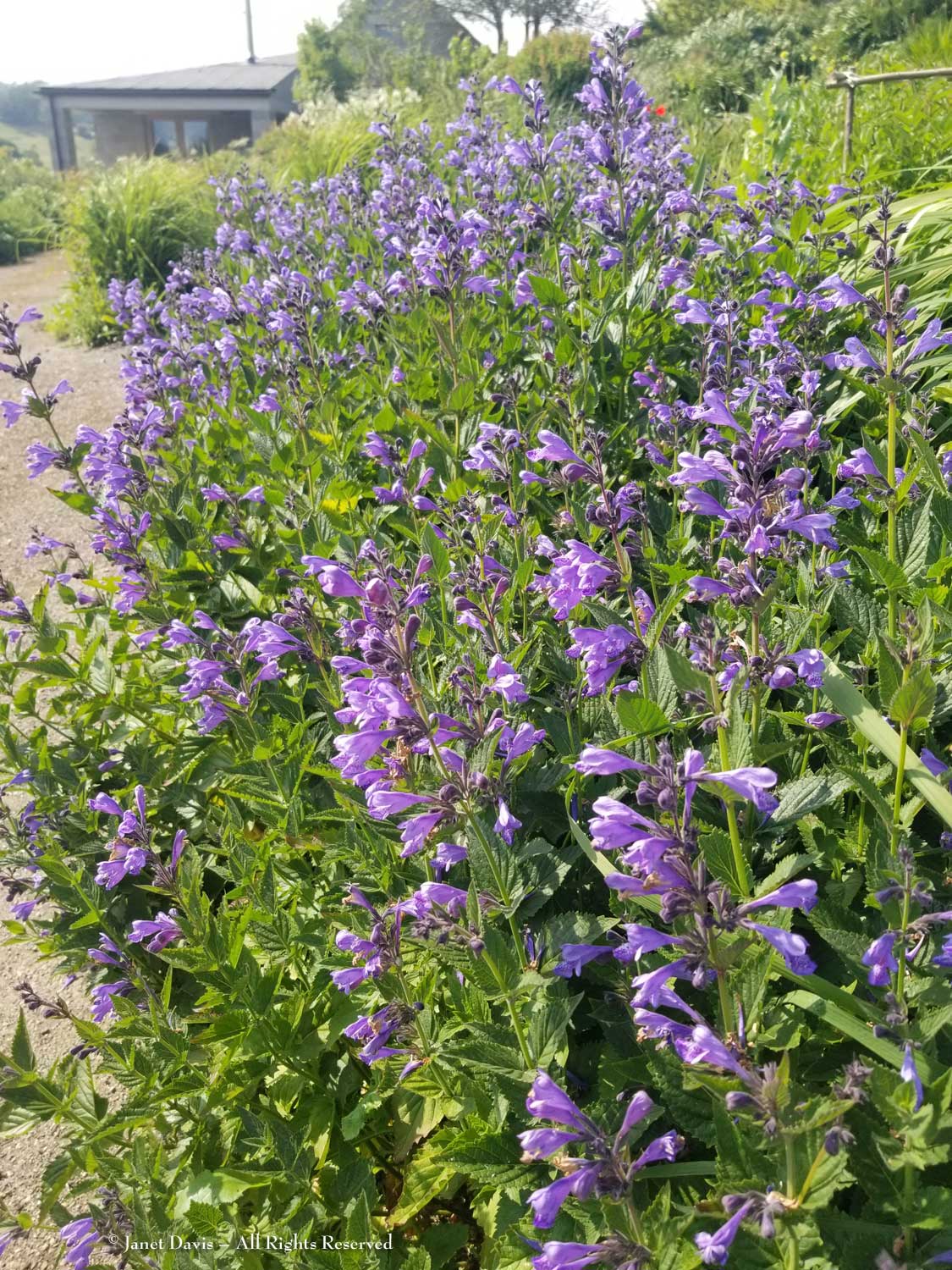
Greek native yellow-banded iris (Iris orientalis) partners with a caramel-colored baptisia in one place…
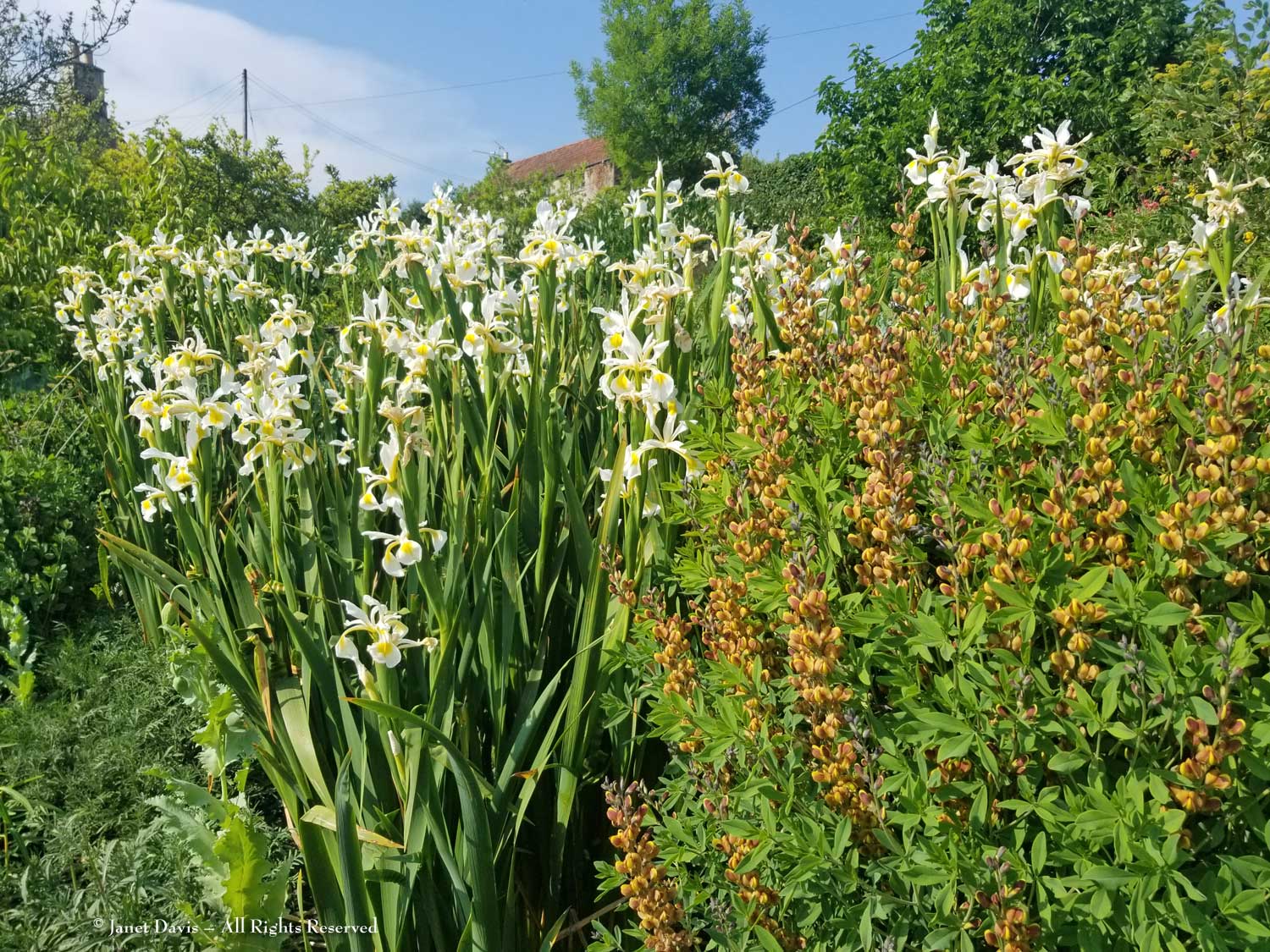
…. while perfumed sweet peas twine pea sticks in another.
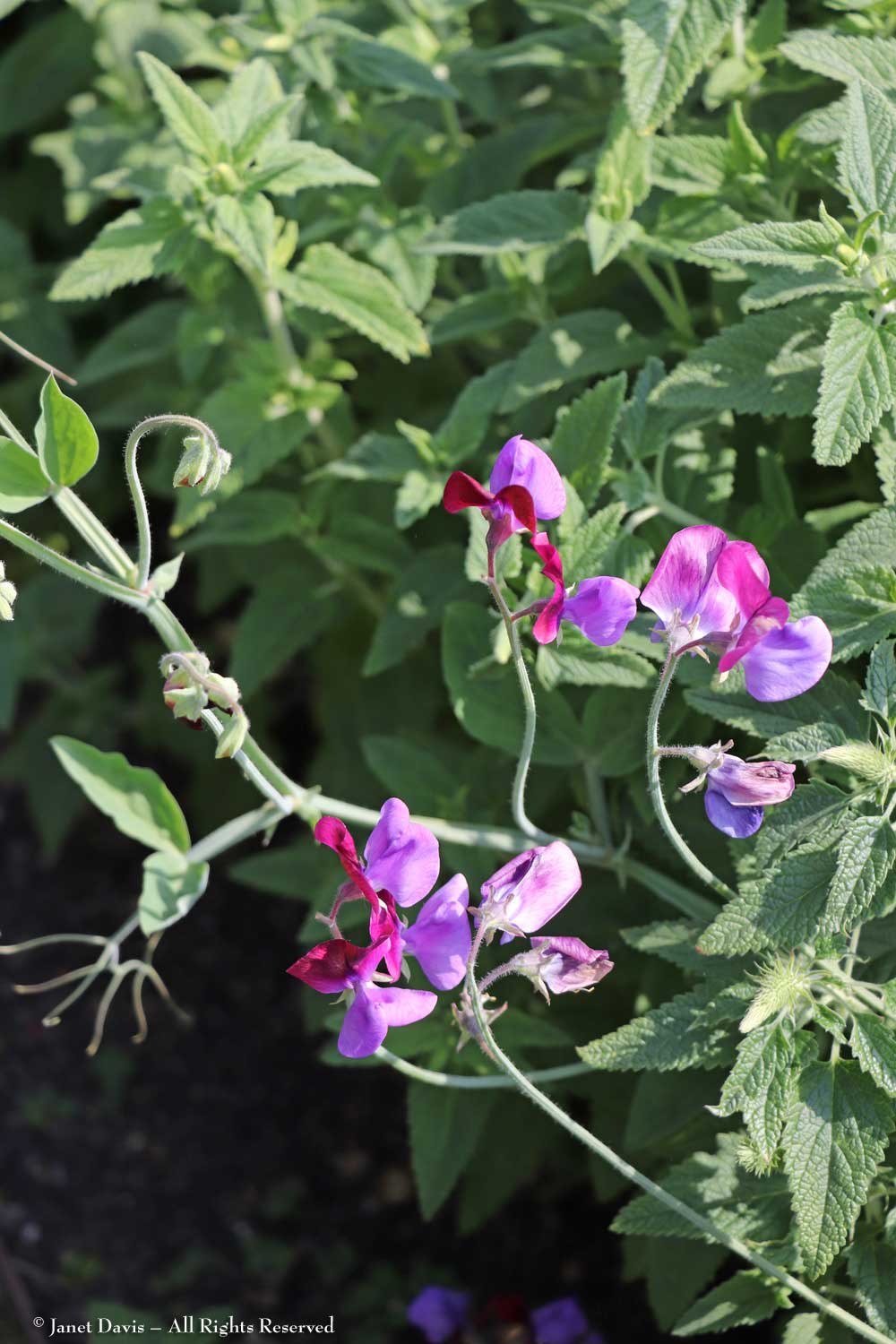
Sulfur clover (Trifolium ocroleuchon) has many of us clicking shutters.
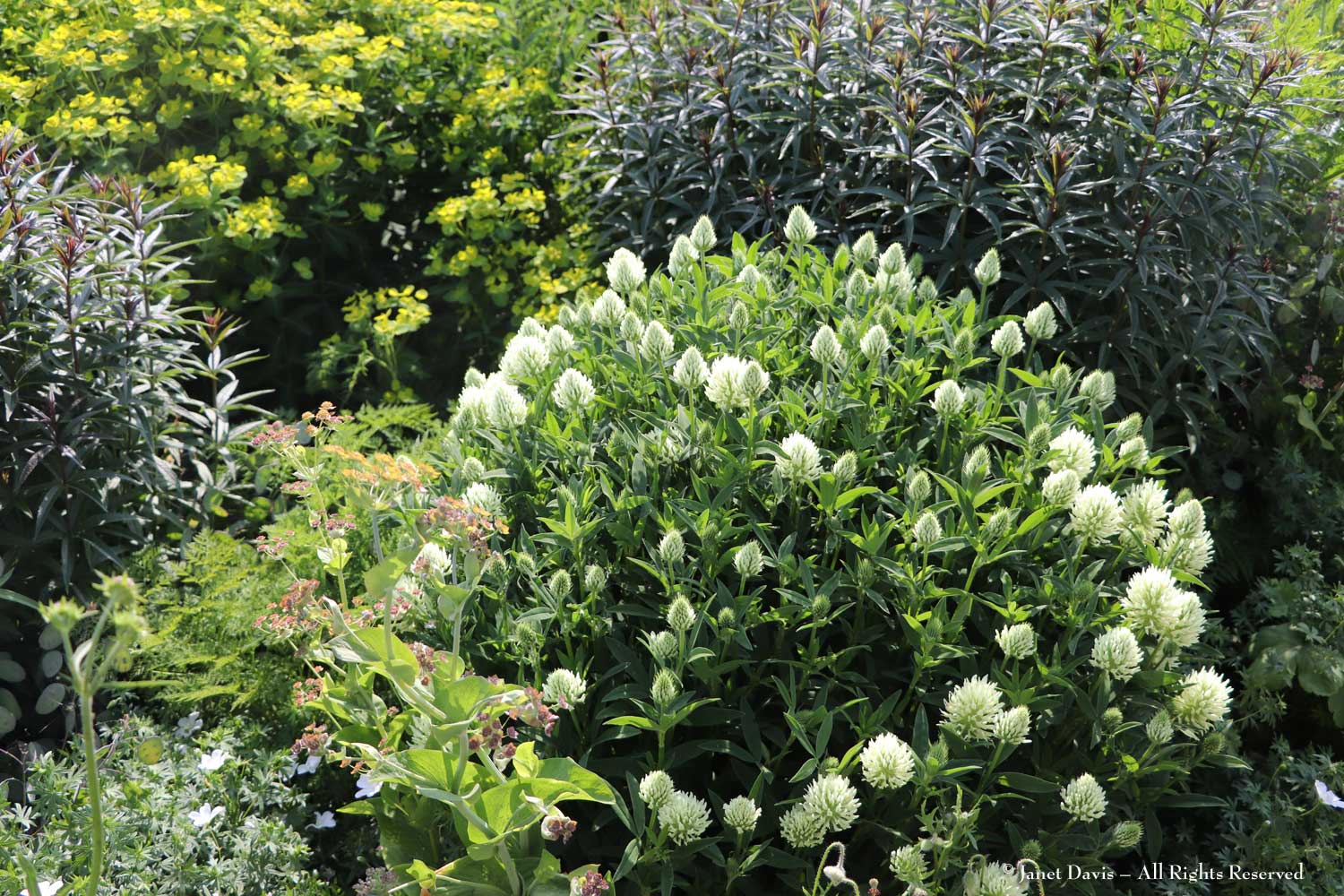
Though it would be lovely to stay another week, there’s just enough time to see the latest chapter at Hillside. This spring, after contemplating the site for a few years and planting it first with a green manure, then a pastel mix of Nigel Dunnett’s ‘Pictorial Meadows’ seeds, a new garden has taken shape. It’s a Mediterranean garden inspired partly by Dan’s work recreating the Delos Garden at Sissinghurst, where he’s been a consultant for almost a decade.
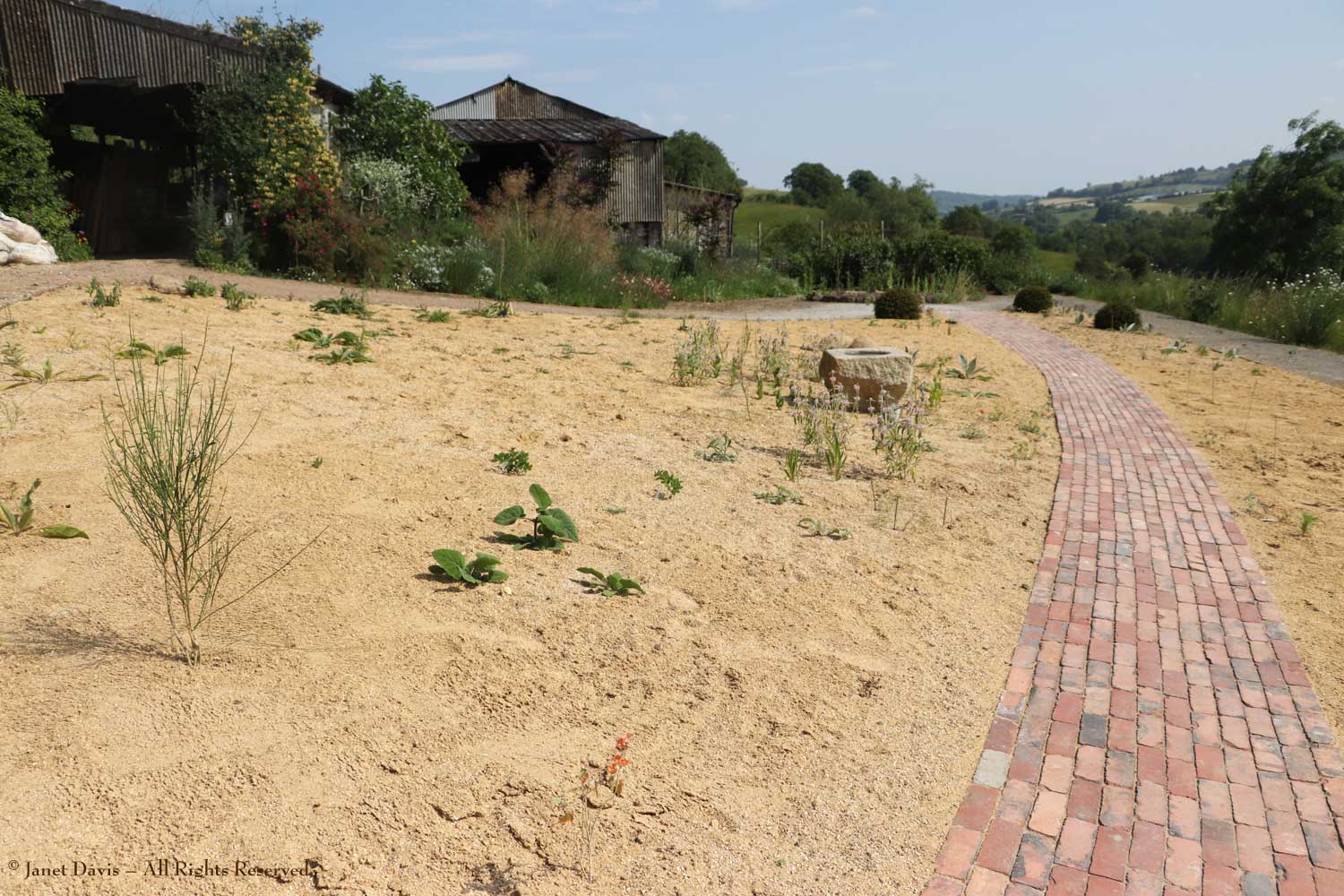
The new garden features a 6-inch mulch of sharp sand, following principles established by Swedish designer Peter Korn. It features drought-tolerant plants such as lilac Phlomis italica, below, verbascums and N. American desert perennials like Sphaeralcea ambigua.
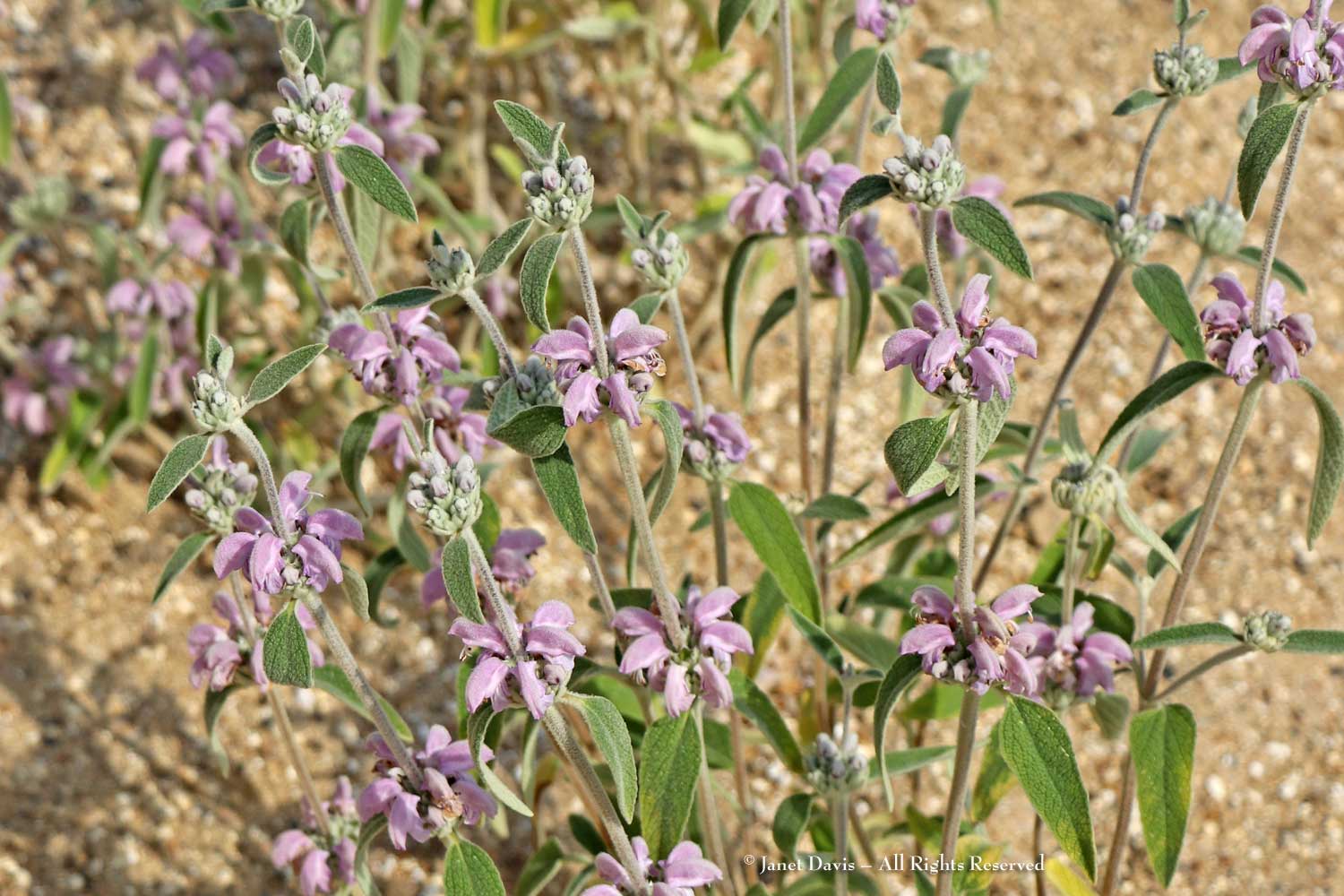
I was fortunate to have visited Sissinghurst the previous weekend and saw the Delos Garden….
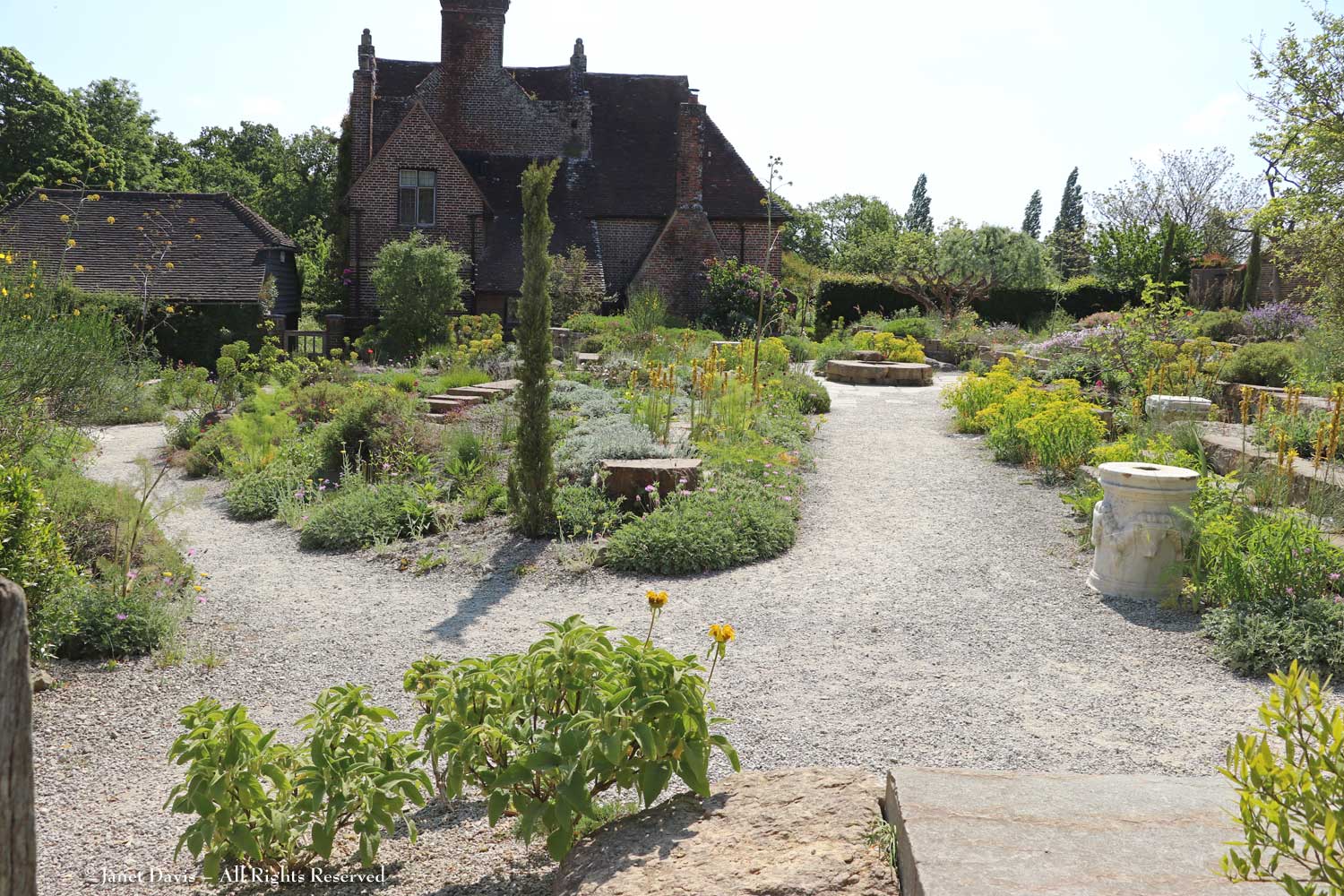
….. richly planted with asphodelines and sages, among other Mediterranean plants.
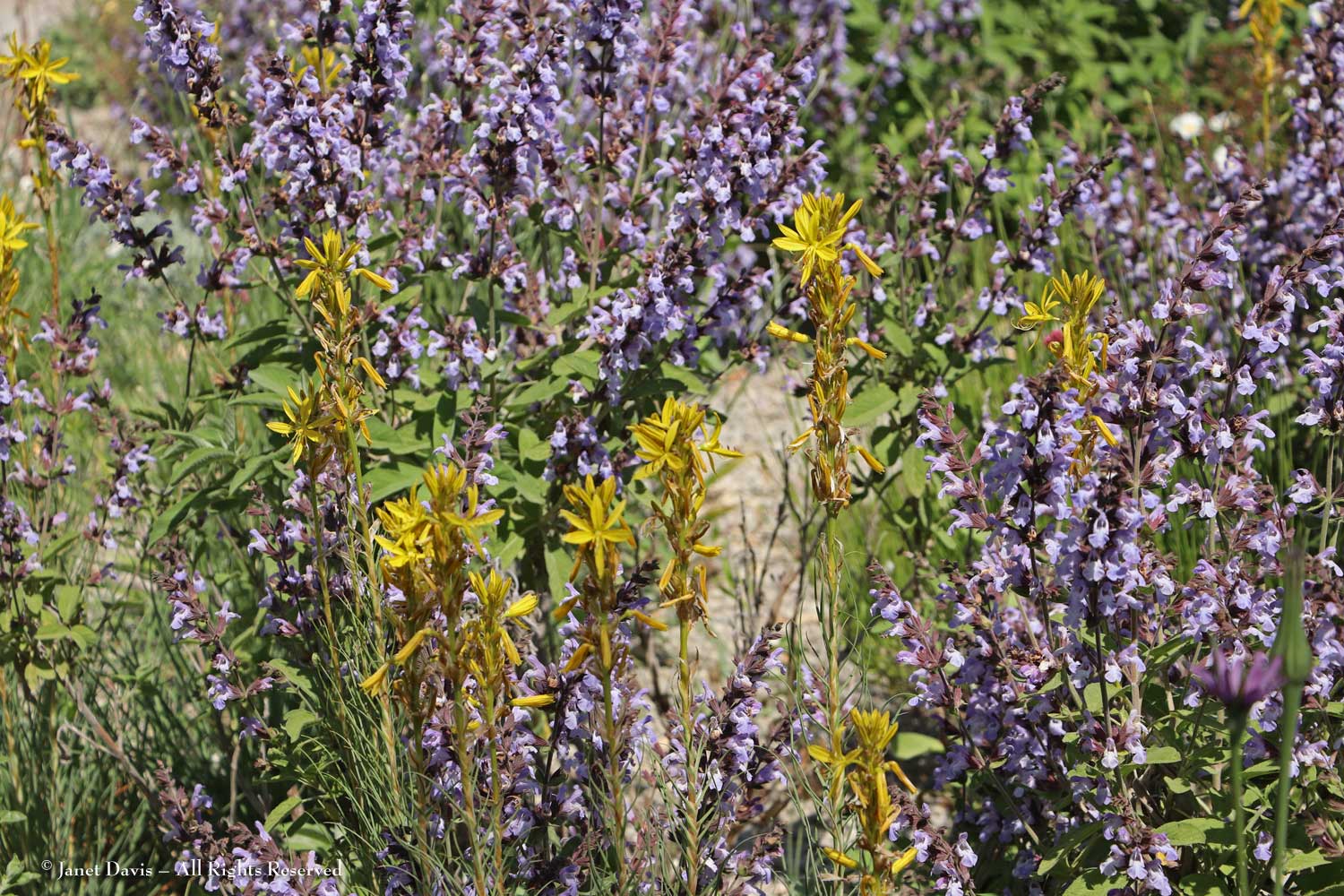
Its stone altars were brought in the 1820s from the Greek island by Vita Sackville-West’s husband Harold Nicholson’s seafaring great grandfather and acquired at auction by Harold when the family house in Ireland was sold in 1936. I have a special fondness for the sacred island of Delos….
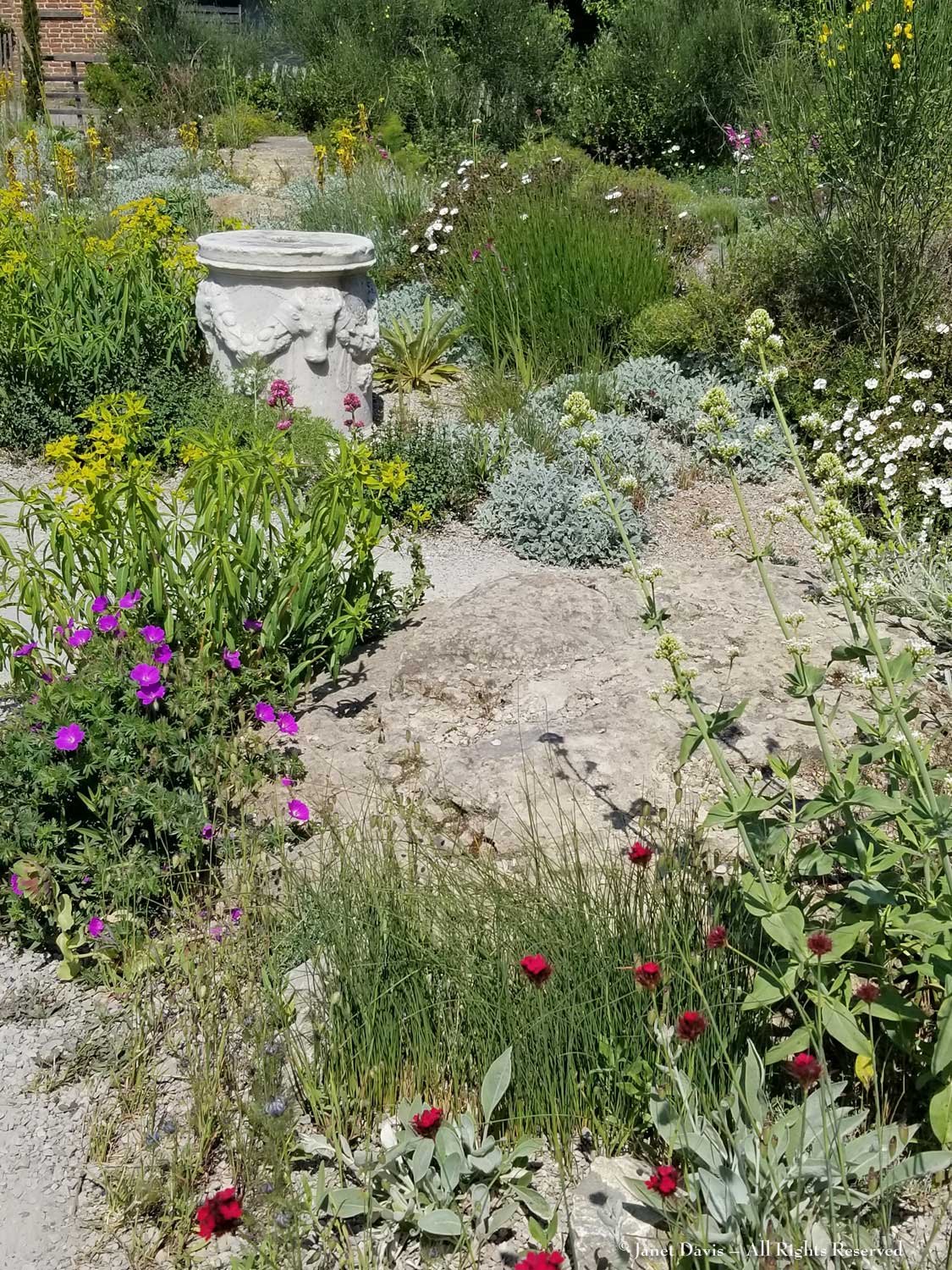
…. having visited myself in autumn more than a decade ago when the grasses and wildflowers had gone to seed and were blowing in the hot wind, below. It was my fervent desire to return one day in spring when the flowers are in bloom, but seeing Dan’s garden at Sissinghurst in early June might be the closest I come.
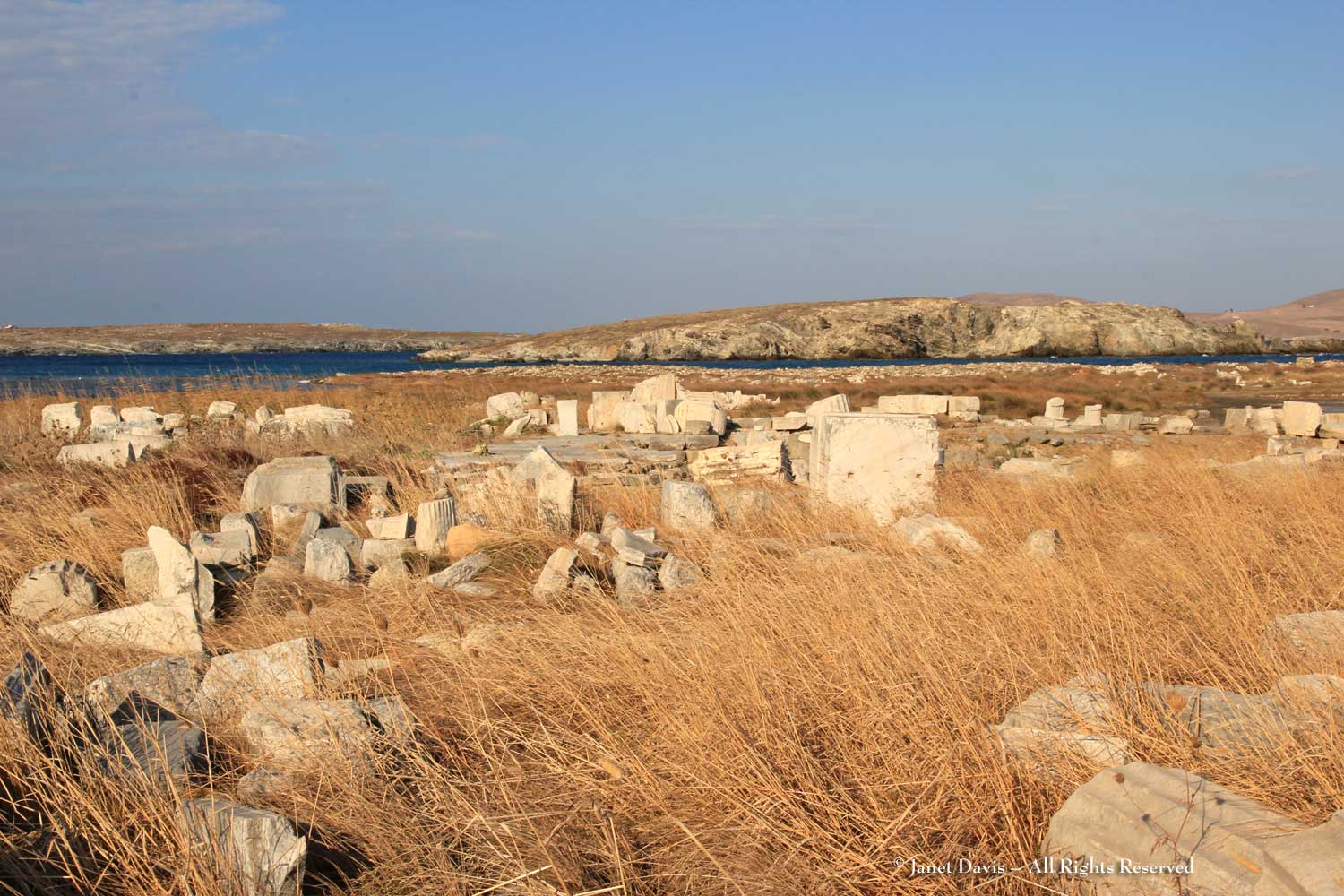
As we head back to the open kitchen, I pass a handsome shrub that Dan tells me is his friend Dan Hinkley’s introduction Hydrangea serrata ‘Plum Passion’.
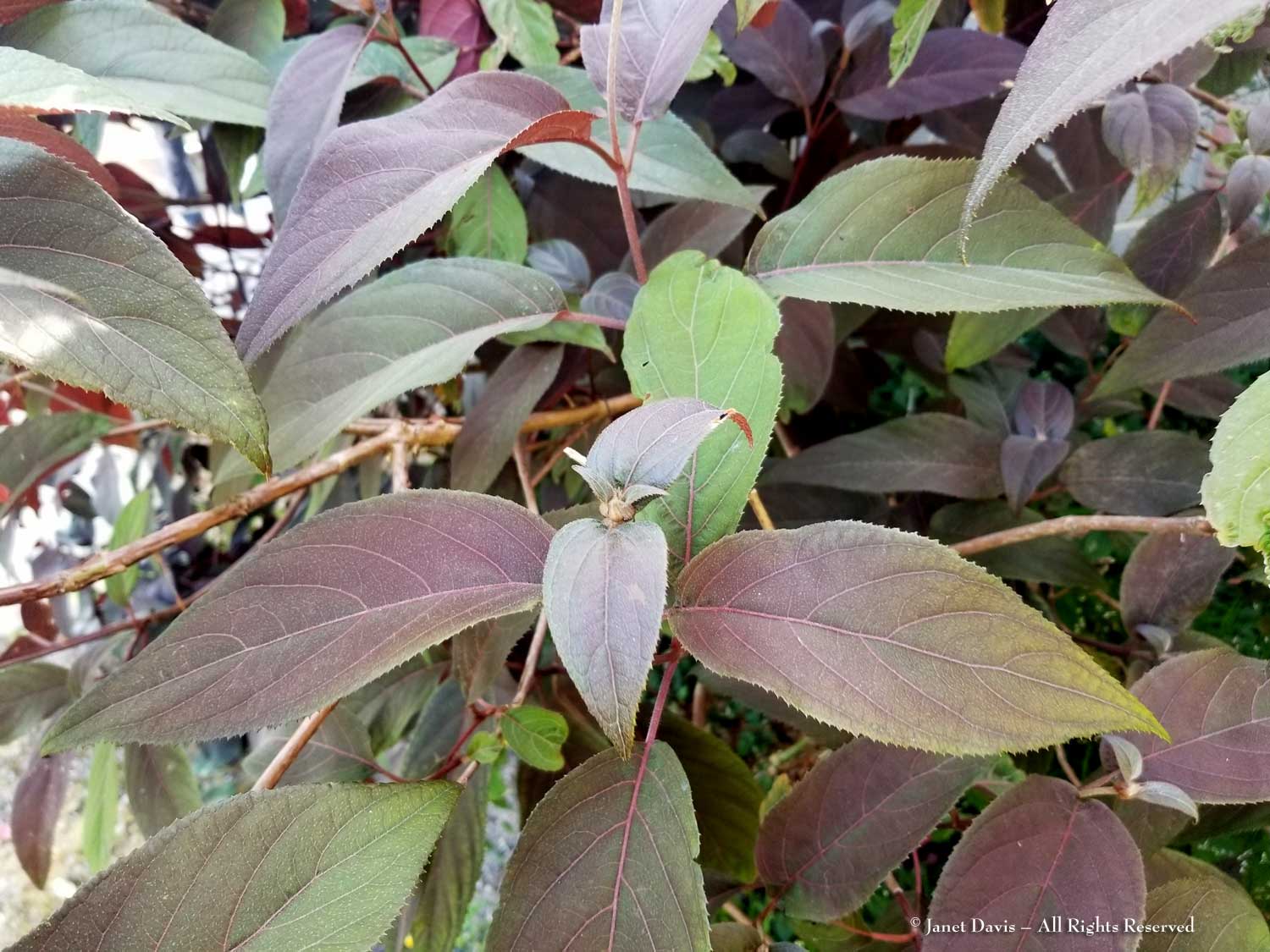
And in a sheltered spot near the house are pots of perfumed dianthus and society garlic (Tulbaghia ‘Moshoeshoe’).
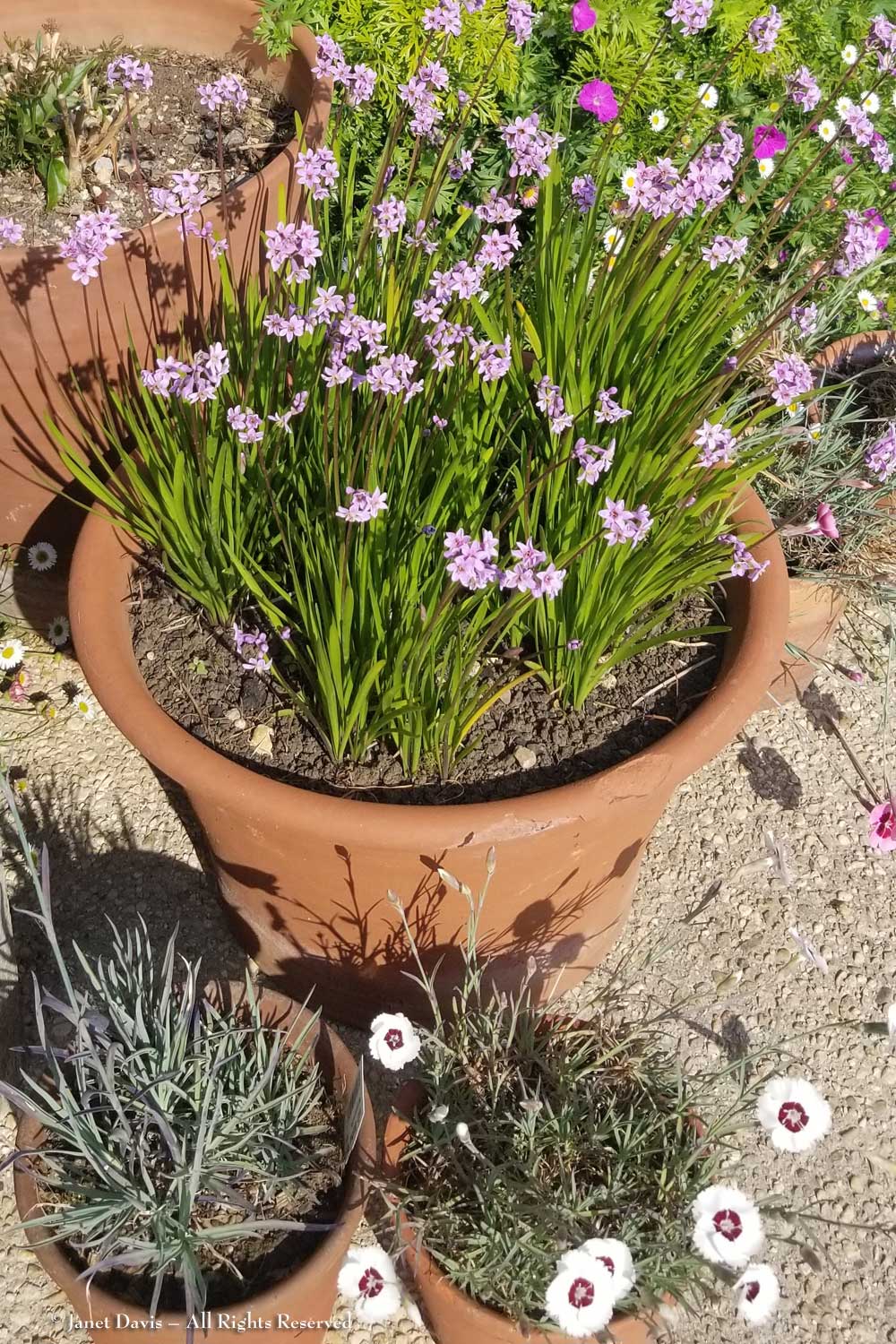
As our visit is coming to an end, we are invited to sit and enjoy the lovely English garden tour custom of “tea and cake”. Huw Morgan has worked his magic on blackcurrants, garnished lavishly with rose petals…..
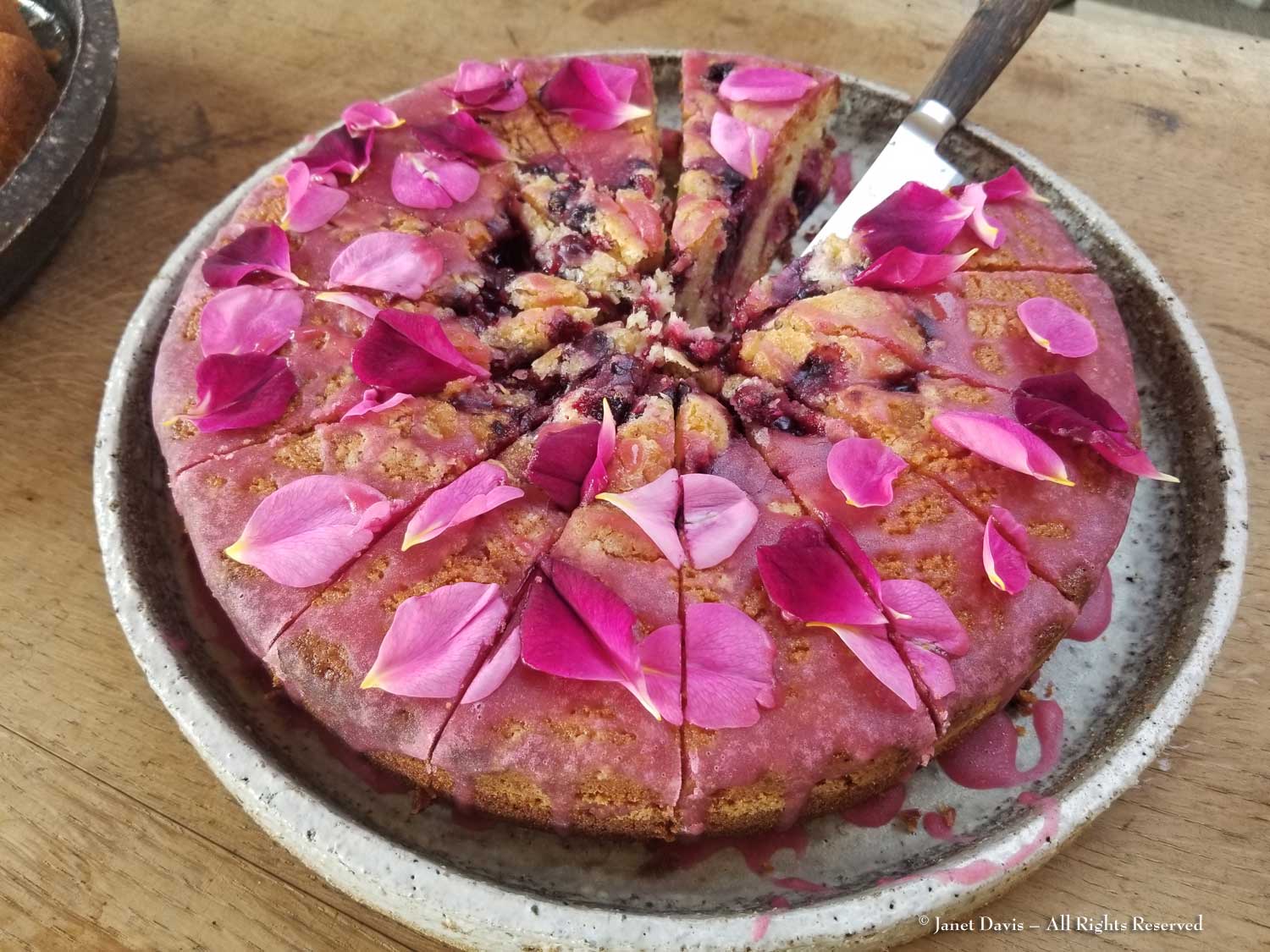
….. and quite possibly the best lemon pound cake I’ve ever tasted, garnished with tiny elderflowers and lemon slices.
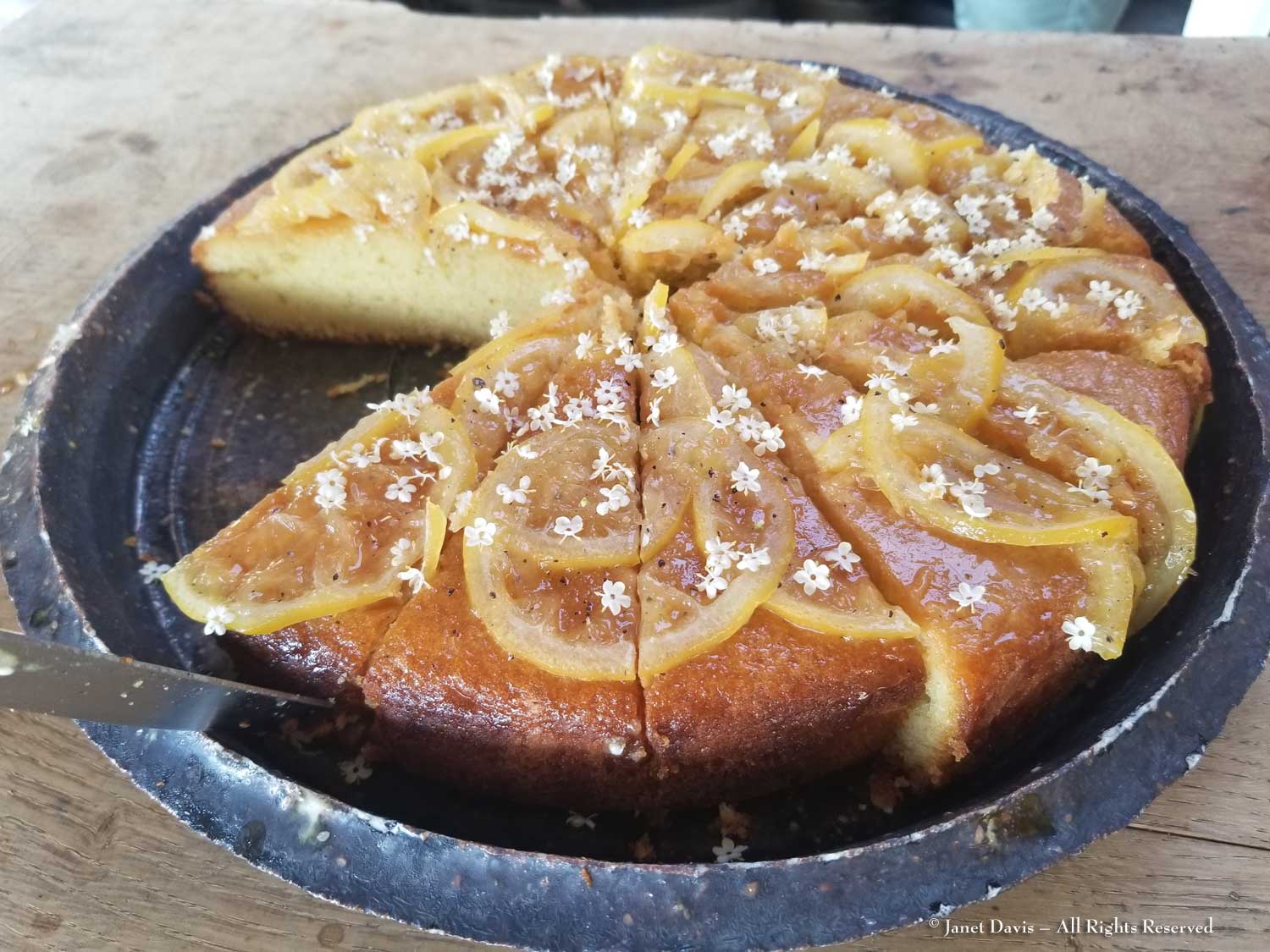
And after the last crumb is finished and it’s time to head into Bath nearby, Dan and Huw insist on posing with us for a group photo – the perfect hosts with the perfect garden at the end of a perfect visit in Somerset.
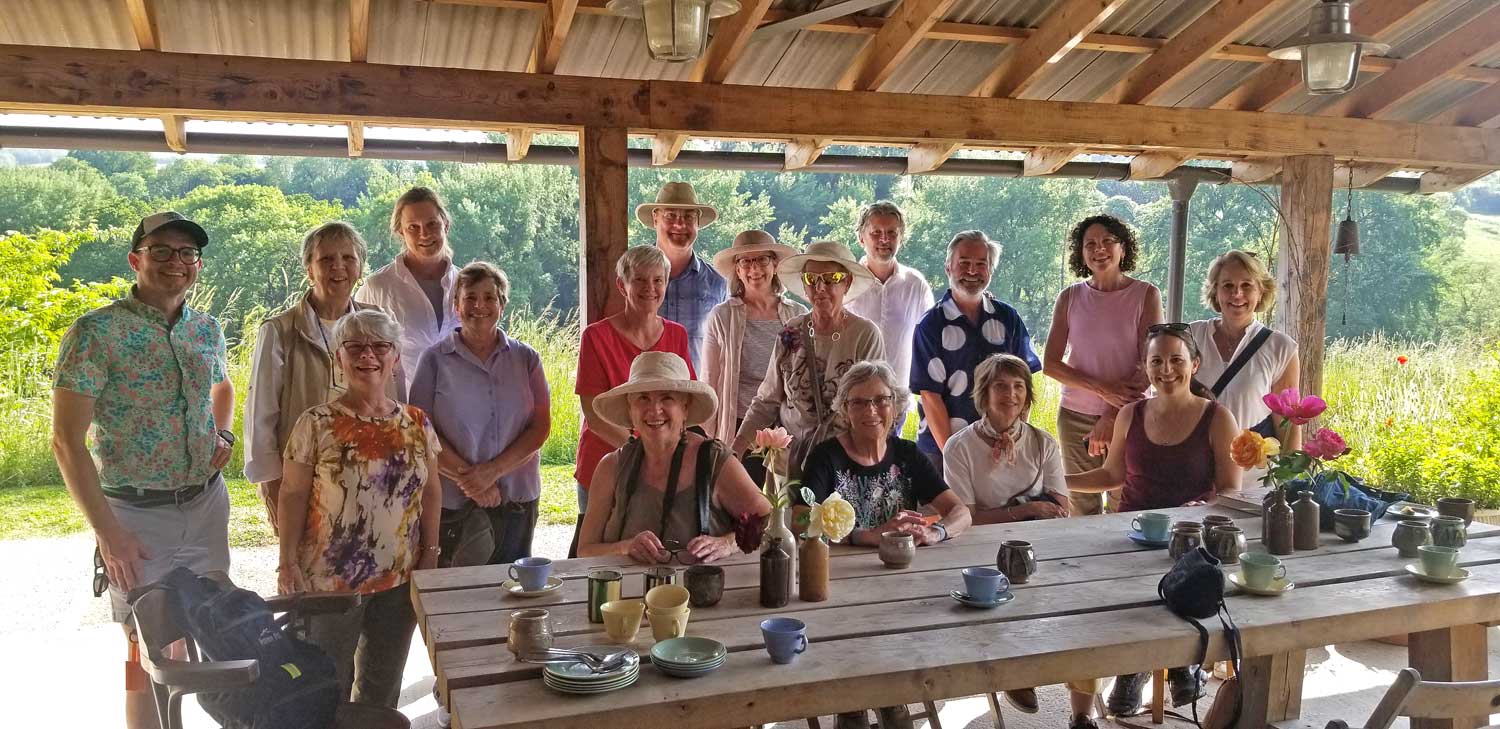
********
If you like naturalistic meadow gardening, you might wish to read my blog on Piet Oudolf’s entry border at the Toronto Botanical Garden, published as:
Piet Oudolf – Meadow Maker Part One and Part Two.
**************
I travelled with Carolyn Mullet’s Carex Tours .
